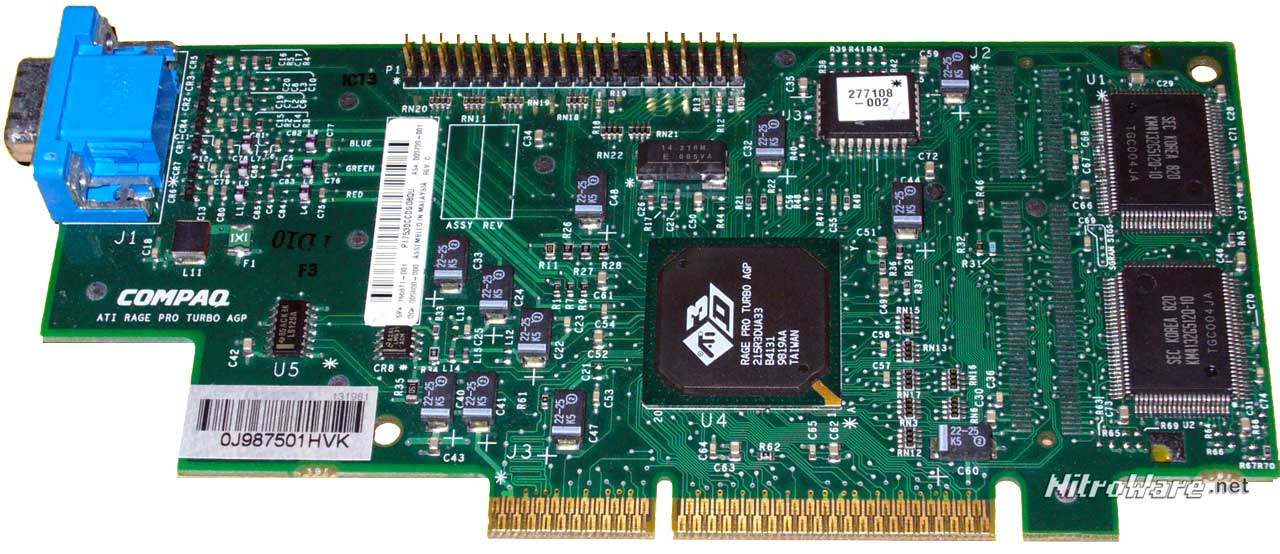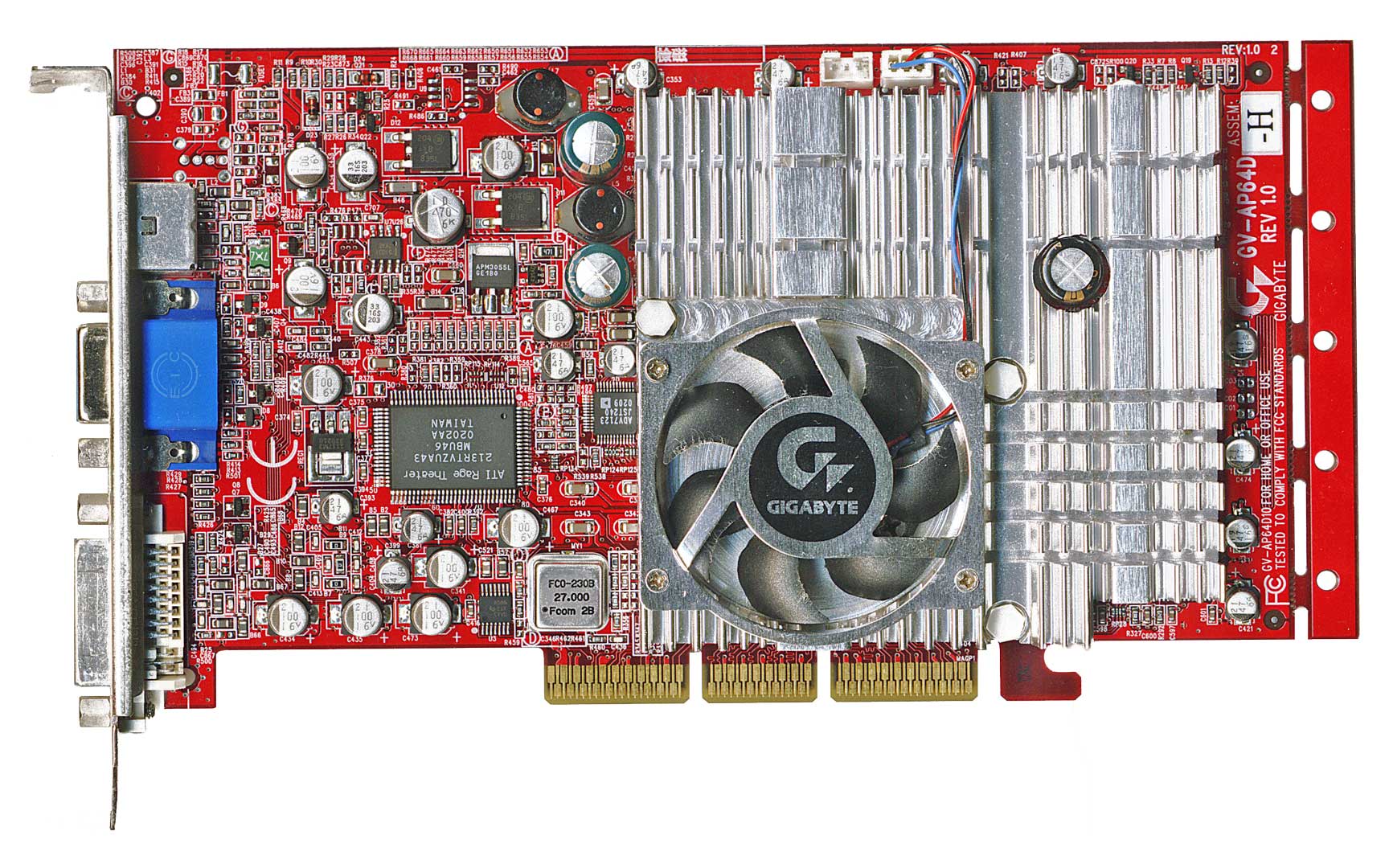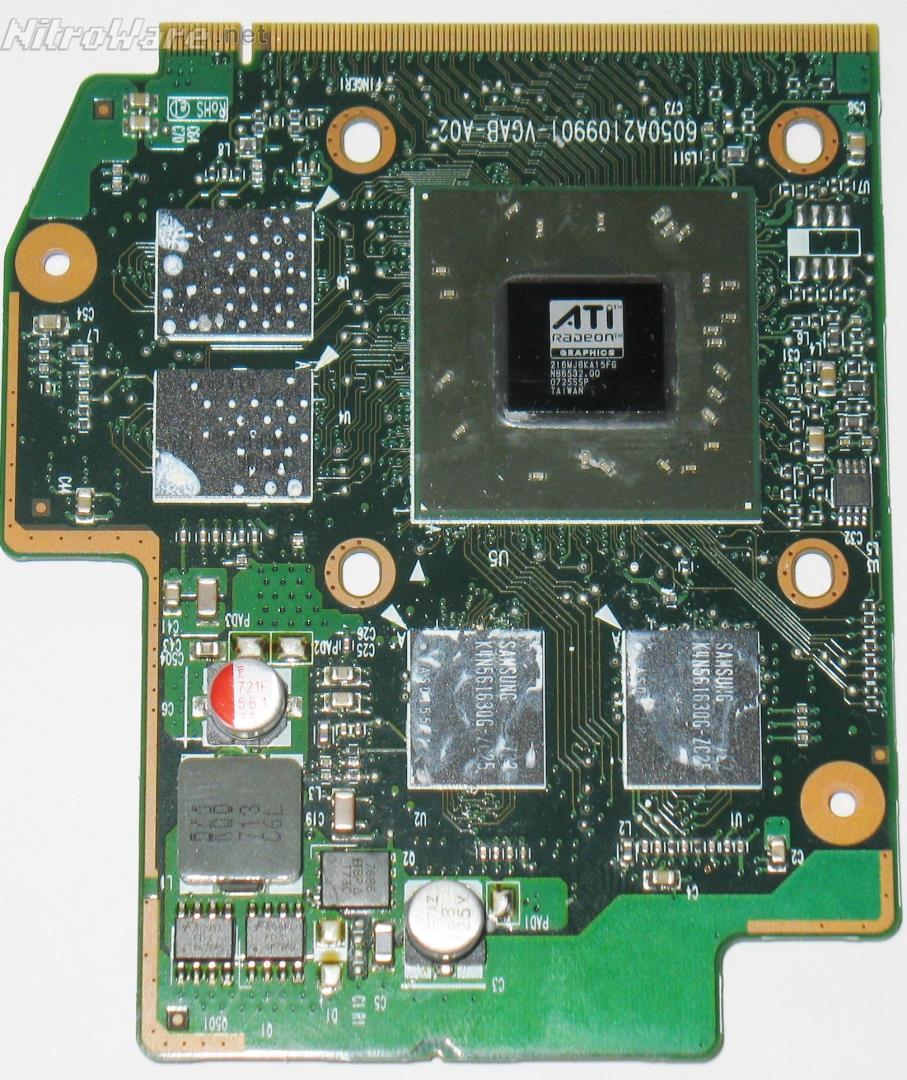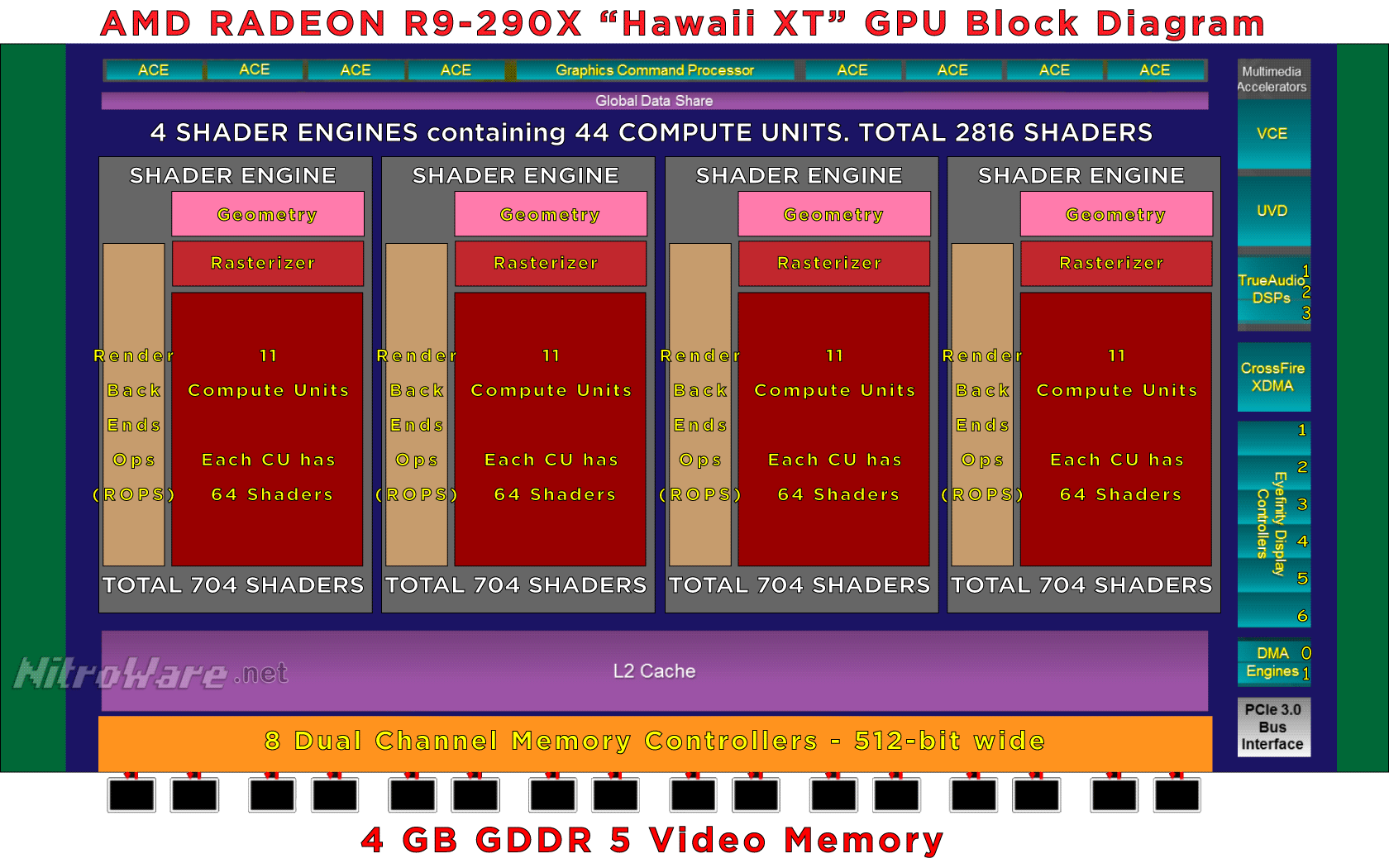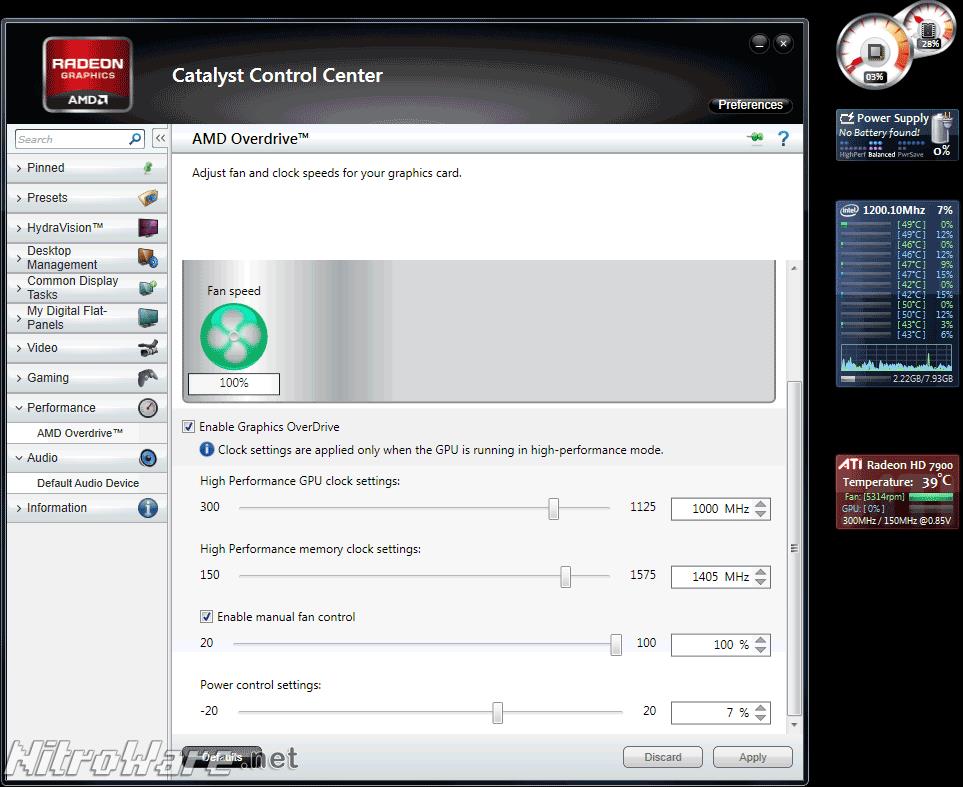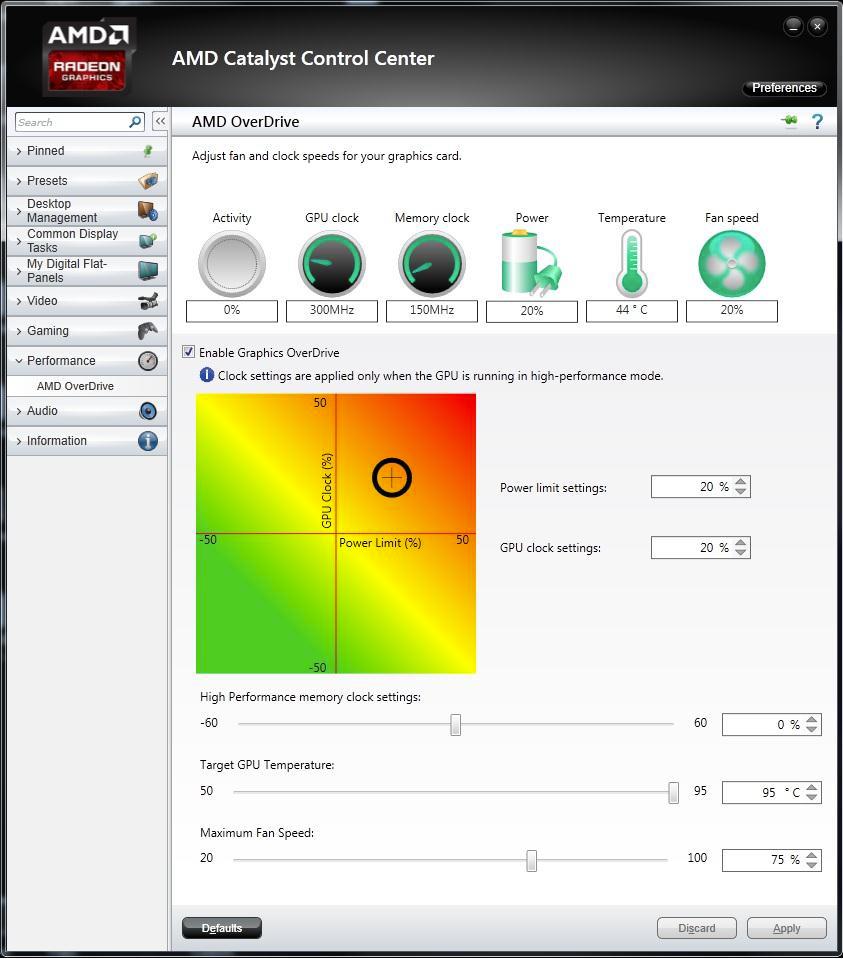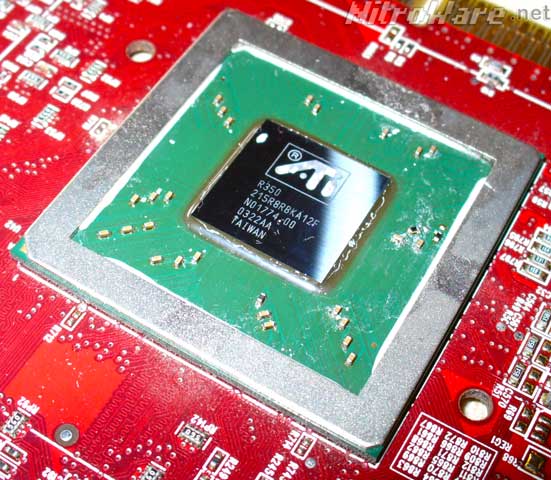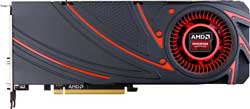
AMD's Radeon R9 290X video card may be a watershed moment in PC graphics, Powered by the 'Hawaii' GPU based on an beefed up version of the Graphics Core Next architecture, this is the first card 'designed for gaming at 4K resolution'.
We analyse the AMD Radeon 290X Hawaii GPU's design and specs, compare AMD and NVIDIA's current GPU and remember Graphics Cores Past. Ten years ago, the for the time powerful R350 based ATI Radeon 9800 Pro launched, 64-bit computing became mainstream and USB 2.0 as well as Wi-Fi became ubiquitous.
The 290X is the latest in what has been a successful line of single GPU high end DirectX 11 Radeon parts from ATI/AMD: HD 5870, HD 6970 and HD 7970. Read on to see if Hawaii and R9 290X continues this legacy.
Background
G
PU vendors tend to take to a tick-tock like approach to releasing new graphics cards and GPU architectures.An all-new architecture is released and over the next two years this architecture will be enhanced, updated and refined as it matures whereas CPU vendors such as Intel have a shorter cadence of 12months between cycles.
Let us look at NVIDIA's 2010 release of their 'Fermi' architecture, in mobile guise these parts lasted through 2012 and early 13 until the entire product stack was replaced with 700 series Kepler Refresh parts.
At the very end of 2011, AMD introduced its Graphics Core Next architecture that it intended for to replace several older architectures. The point of this technology was for the company to have a single, very scalable Graphics Engine that could be used in low and high performance solutions easily, but also goes the distance lasting several years. At some time in the future this architecture could be updated to meet needs of the time rather than designing a new system from scratch.
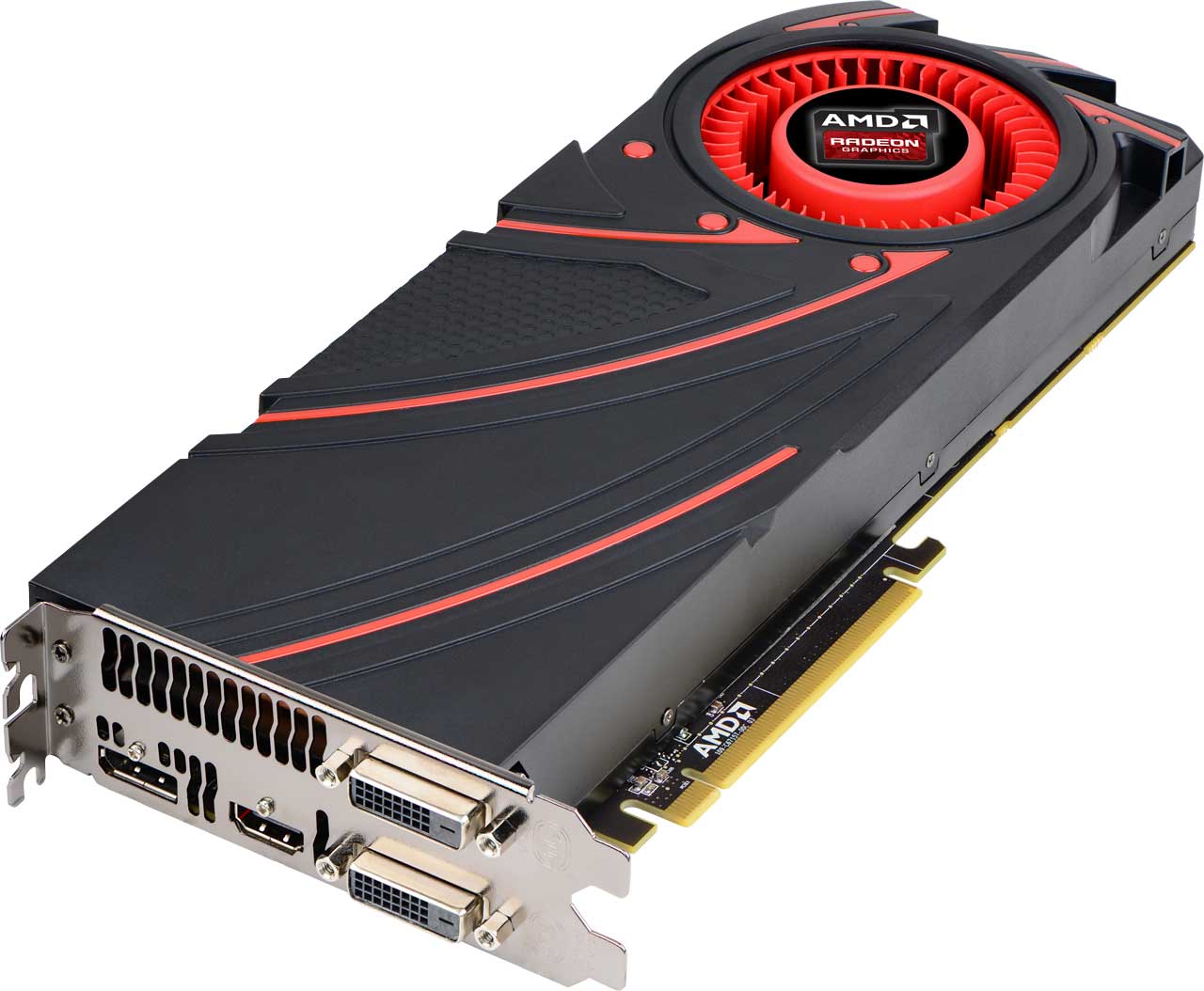
As Radeon HD 7000 is now nearing the end of product cycle, for 2013-2014 AMD is announcing a new top to bottom stack of GPUs. Some of these are built using a new GPU; others are boosted versions of the 2012-13 GCN products.
There has been some negative response to this rebranding by enthusiasts, however this *nothing* new. Both AMD and NVIDIA have been doing this for the past ten years, ever since NVIDIA released their NV10 'GeForce' and AMD their R100 'Radeon'. There is simply no reason to design a clean sheet GPU when the current solution is more than adequate in features and whose performance can be improved as chips gain maturity, unlike older GPUs where performance was limited by bottlenecks in the chips logic blocks or memory bandwidth.
For 2014 AMD have updated and enhanced Graphics Core Next, 'fixed its plumbing', scaling it up, making it better faster wider and stronger.
All the lessons learnt by AMD since quarter 4 of 2011 and chip tape out have been applied to Hawaii's enhanced GCN design. These bug fixes and enhancements improve the end-user experience of AMD Radeon.
No microprocessor is perfect. Just as soon as a design is locked down, work is begun on updates to the chip. The same methodology is used for the industry stand software development life cycle. The line has to be drawn somewhere, sometime and not all features or bug fixes get to make it into a product release. These will be held for the next release.
It has now been ten years since one of ATI's previous watershed moments in graphics, the ultra-successful R300 based Radeon 9800 series with a for the time very wide 256-bit memory bus. In 2013 we are looking at another watershed moment with the 'optimised for 4K' Hawaii based 290X cards but competition is fiercer than it was back then. The R300 was one of the first cards to have an optional 256MB frame buffer, Now 290X offers 4GB standard and AMD claims it needs it.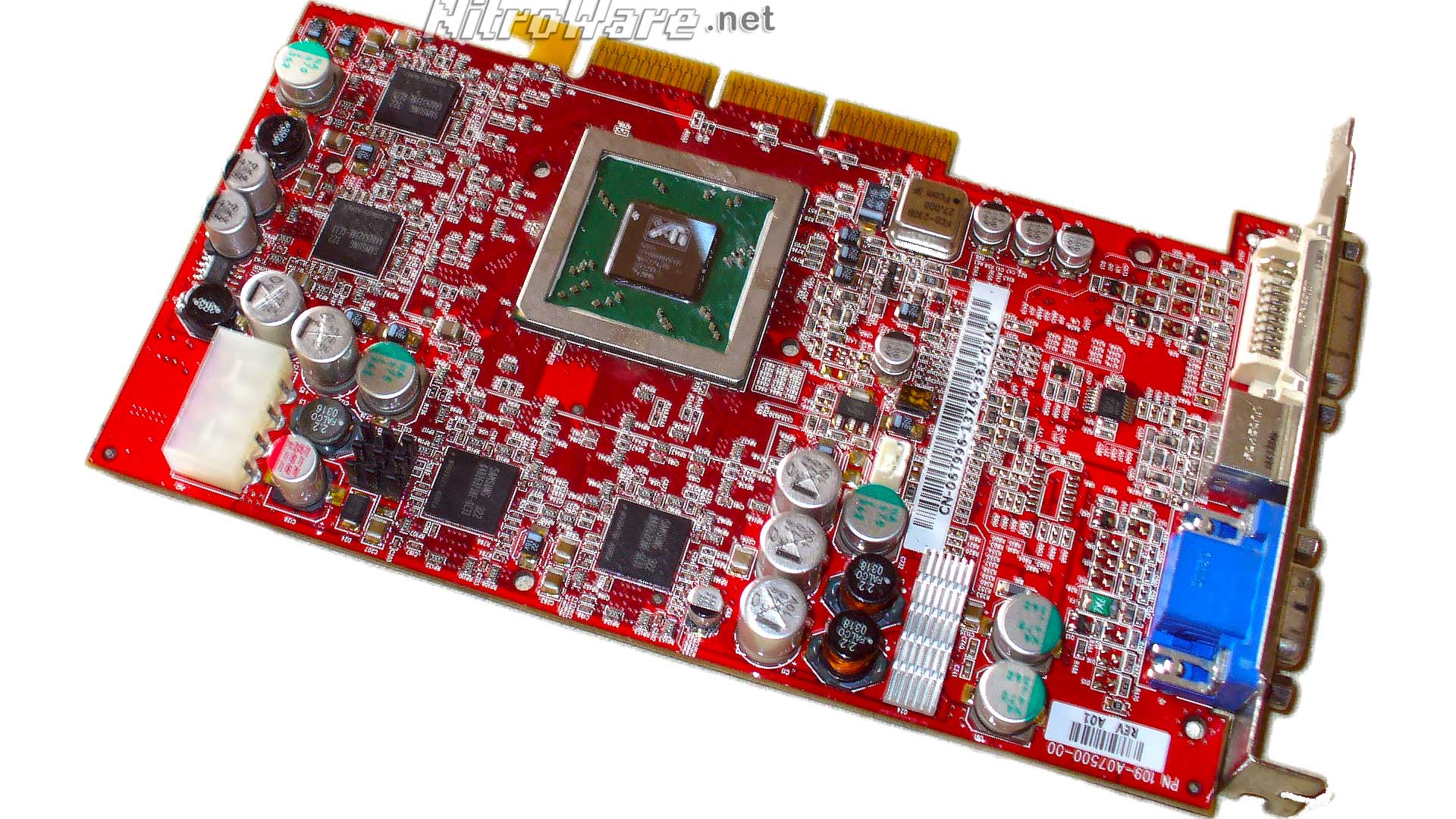
Graphics Core Next: Revisited
Last year in slide fashioned to AMD's own style, proposed was a GCN 2.0 based successor to Tahiti (Radeon HD 7900), codenamed Tenerife of the Canary Islands which was supposed to be a higher performance update and refreshed flagship GPU. As time went on this was proven false however the GCN 2.0 lingo stuck, despite AMD's insistence that GCN was a long term and highly scalable architecture.
Then came the announcement in 2013 that GCN was 'stable throughout 2013', prompting anger from some enthusiasts who could not fathom the concept that their next GPU may be powered by a two year old architecture.
Reading between the lines, the real statement was obvious. As was the case previously with the December 2011/January 2012 launch of Radeon HD 7970 and the HD 6900 in late 2010, new high end 2014 model year GPUs would be announced during Q4 2013 with higher volumes shipping during 2014.
GPUs, like their CPU cousins follow a tick tock like cadence with alternating new architectures and updates/refreshes; however, die shrinks are less frequent due to the die size and complexity of GPU cores. AMD has success and stability with 28nm process node and wants to keep it that way, with lessons learned from difficulty of previous chip shrinks.
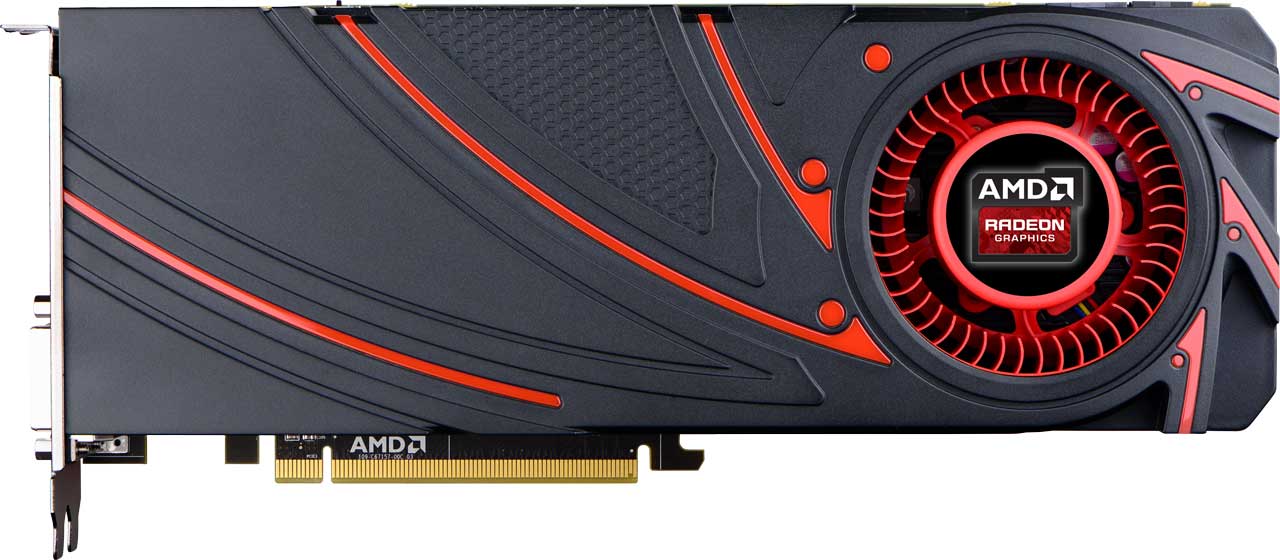 The new Radeon R9 290 series, codenamed Hawaii of the Volcanic Islands family, is not formally based on 'GCN 2.0'
The new Radeon R9 290 series, codenamed Hawaii of the Volcanic Islands family, is not formally based on 'GCN 2.0'
Some sites have referred to HD 7790 Bonaire, R7 260X plus console GPUs as GCN 1.1 and R9 290 as GCN 2.0. This may be an appropriate description to describe updates to GCN, however AMD explained to us that they do not use these classifications to describe the arch that powers the 290 series.
AMD's own slides refer to the architecture as 'GCN revisited' and our during our briefings with AMD on it was agreed upon that 'enhanced' GCN would be a, but not the only more accurate description of the changes made to GCN for the 290 series.
This makes sense in that a future reworked GCN arch may align more to a 2.0 title than what is currently used for Hawaii.
AMD have four pillars that define the enhancements to GCN for 2014:
- Faster performance
- Higher Efficiency
- New graphics features
- New compute features
From a technical view, these are achieved by tweaking a chip's design. Bug fixes, enhancements to logic units, more or bigger cores, interconnects and buses; bigger caches and robust power management.
Looking back at two years of Graphics Core Next
ATI, later AMD endured several major evolutions in its graphics architecture which mirrored industry developments and major revolutions in the PC and graphics industry. At times Radeon graphics was used by Microsoft for the development of their DirectX APU. All roads lead to GCN, which encompasses AMD's vision for a graphics core that can scale top to bottom, for high end gaming graphics cards, consoles and tablets.
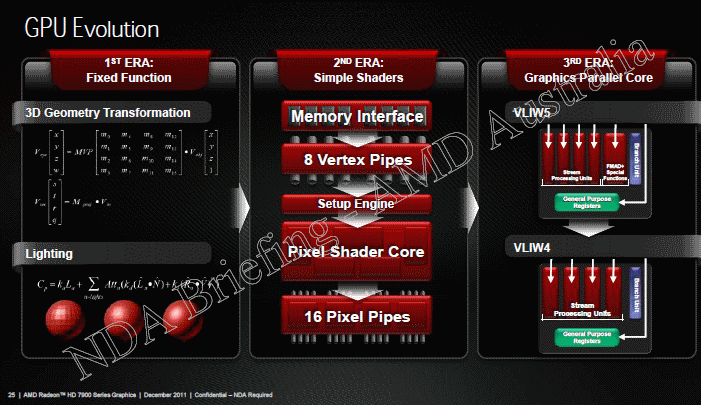
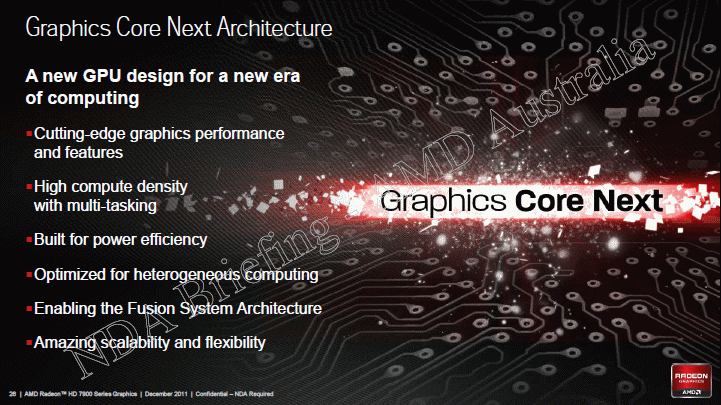
The design goals for the original GCN at launch sound remarkably familiar to those for R9, with the exception being heterogeneous computing which is still somewhat undeveloped and Fusion which is now rebranded as HSA.

Tahiti resembles a 'stack of Lego bricks' which, Compared to Hawaii
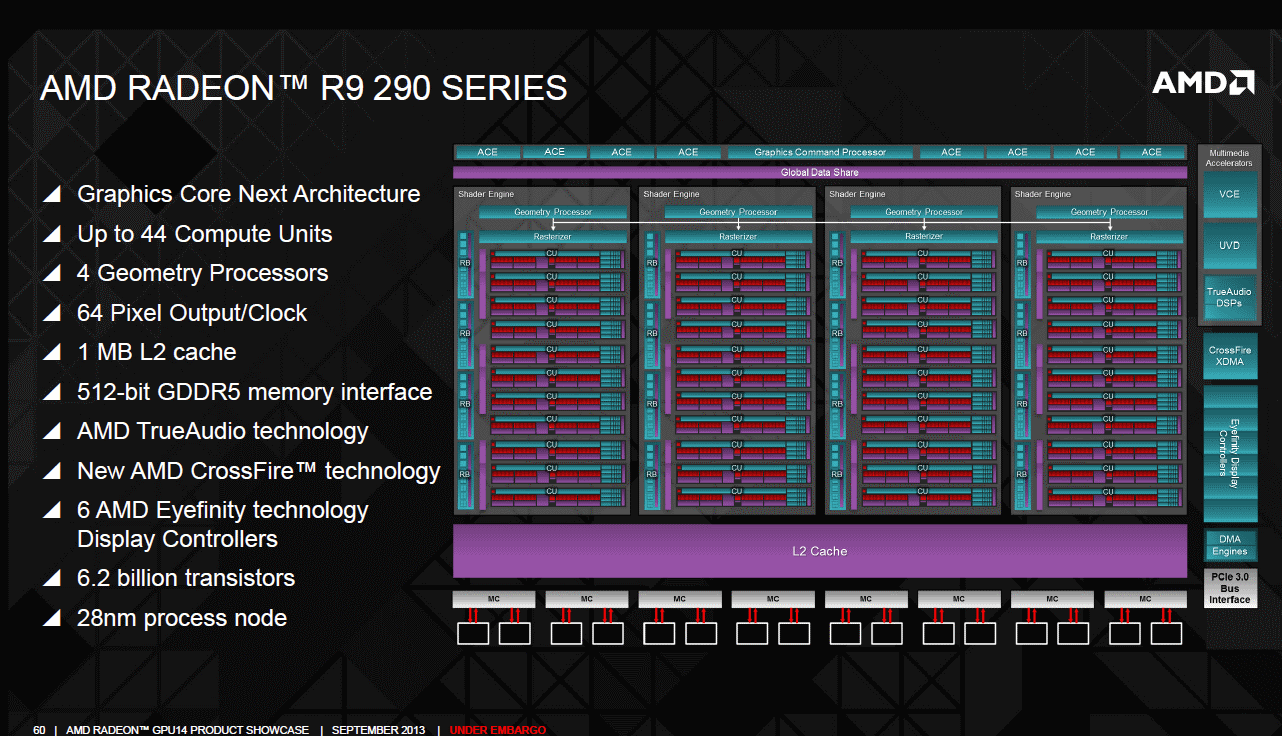
Hawaii's GCN '2.0's hardware resources are organised into is organised into four units called "Shader Engines" which allows resources to be scaled and shared more effectively. This effectively mirror's NVIDIAs approach with Kepler expect their name for the topology is SMX units.
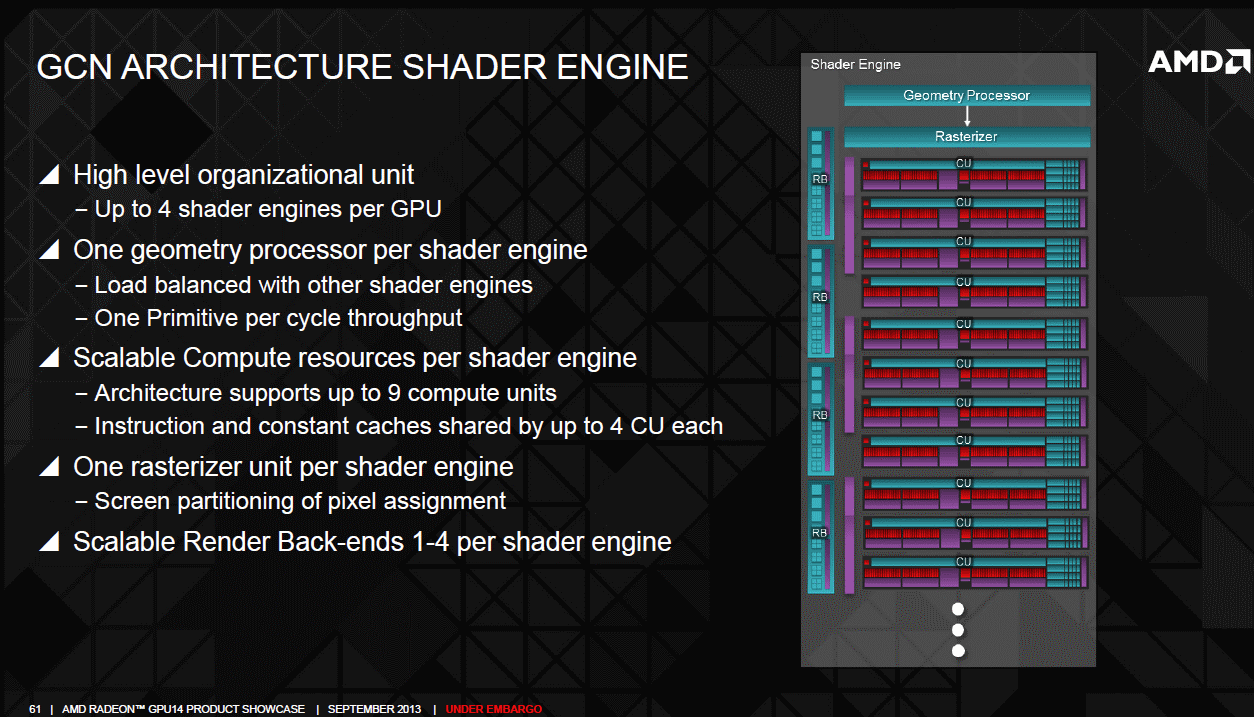
This allows for GPUs to be scaled down more easily by disabling an entire Shader engine (or SMX units) without re-spinning the entire chip to reduce the number of cores or fusing off clusters of cores. There is still some resource sharing within resources contained in each shader engine such as renderers and caches.
Each Shader Engine contains1 rasteriser and 1 Geometry Unit which can load balance, 1 Shader Engine is sufficient to operate the entire GPU.
This diagram shows a simplified overview of the graphics pipeline
- The Graphics command processor overseas operations across load balanced resources
- Geometry is setup and tessellated in The Geometry processors. Data can be exchanged with the compute units if needed or sent to Rasteriser directly.
- The compute units execute pixel shaders or perform GPU computing on the scene
- Pixel data is then passed onto the rasterisers which handle assignment or partitioning of pixels on the screen as well as Hierarchal Z sorting, i.e. the pixels depth in the scene
- Finally, the Render Back Ends handle Pixel Depth Testing as well as stencilling and colour operations
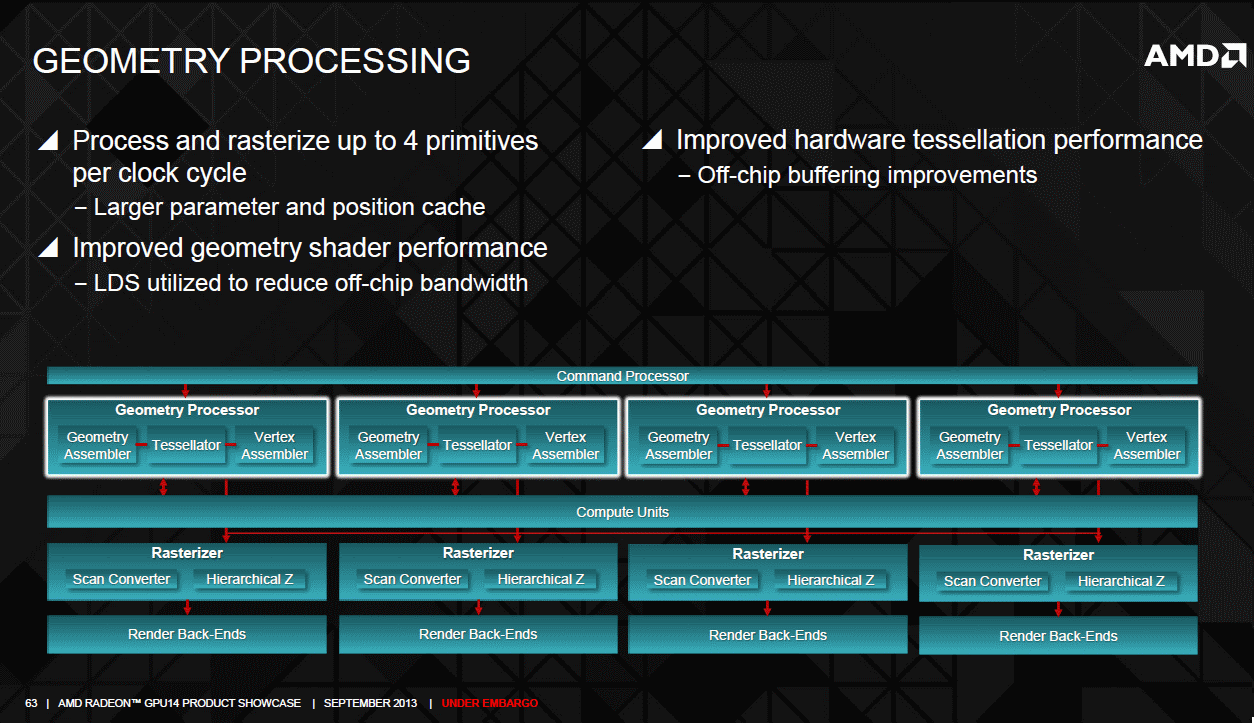
Further to do actual processing, Each of Hawaii's Shader Engines contain 11 Compute Units. The Compute Unit is the smallest physical processing block of the GPU containing all of the necessary low level building blocks that a compute processor needs to fetch, decode and execute instructions.
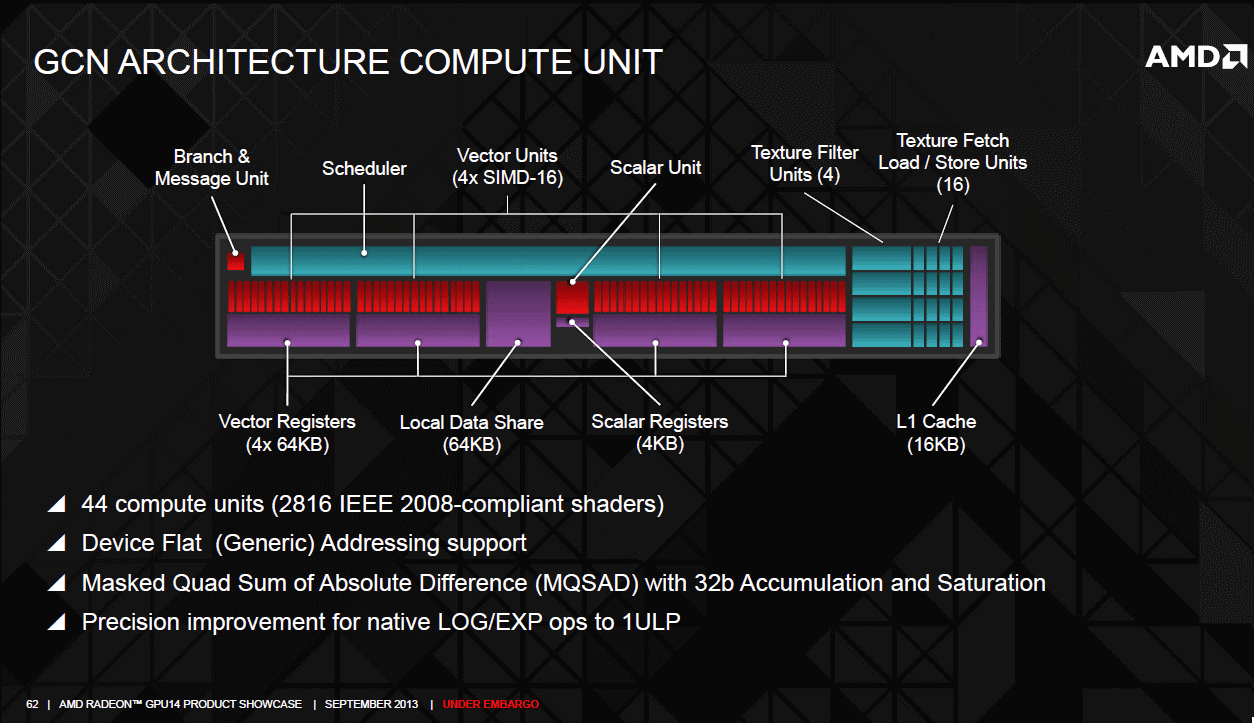
The final stage are the Render Back Ends which handle operations relating to the scene's Z(Depth), Stenciling and Color.
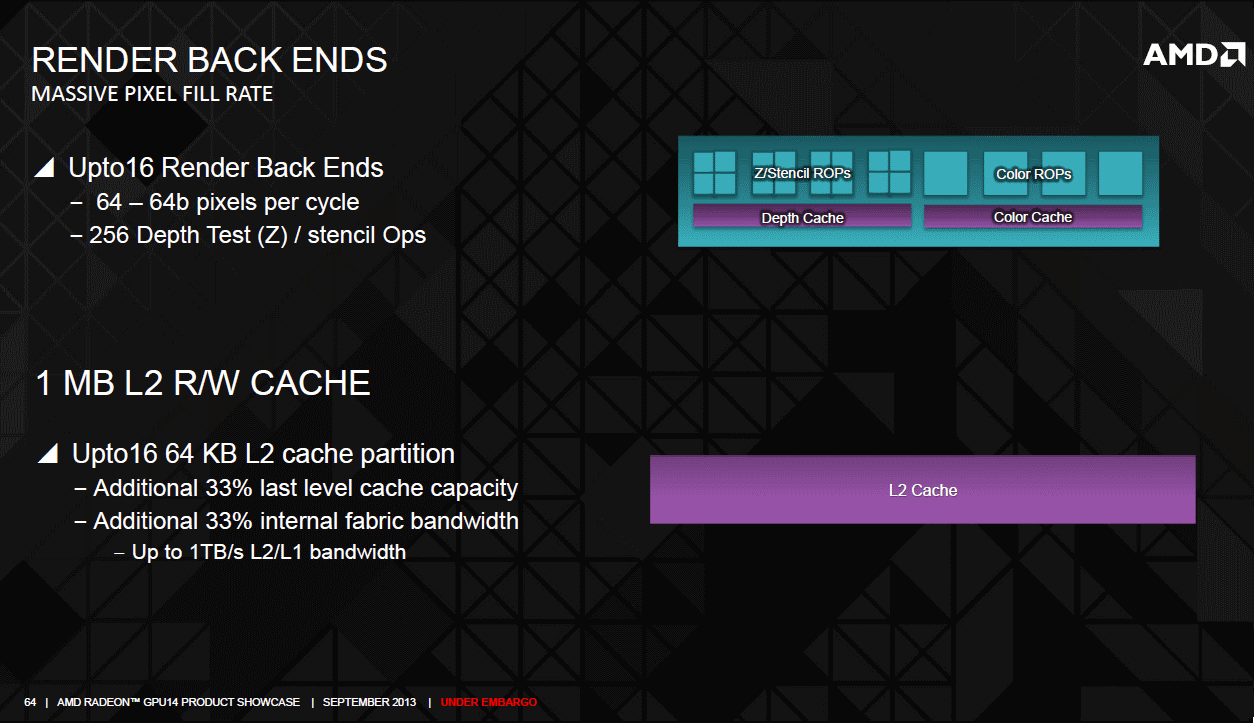
That is all the graphics and compute processing pipelines explained, but a GPU many processors in parallel, which need to be fed tasks and be directed.
We need a means of scheduling and dispatching to allow the GPU to perform multi-tasking across its parallel computing units. This is where the Asynchronous Compute Units come in, which Hawaii has 8 of which are independent of the Shader engines. The ACE units queue, store and share data for use in GPU computing across the entire GPU. Graphics specific commands are issued by a separate command unit.
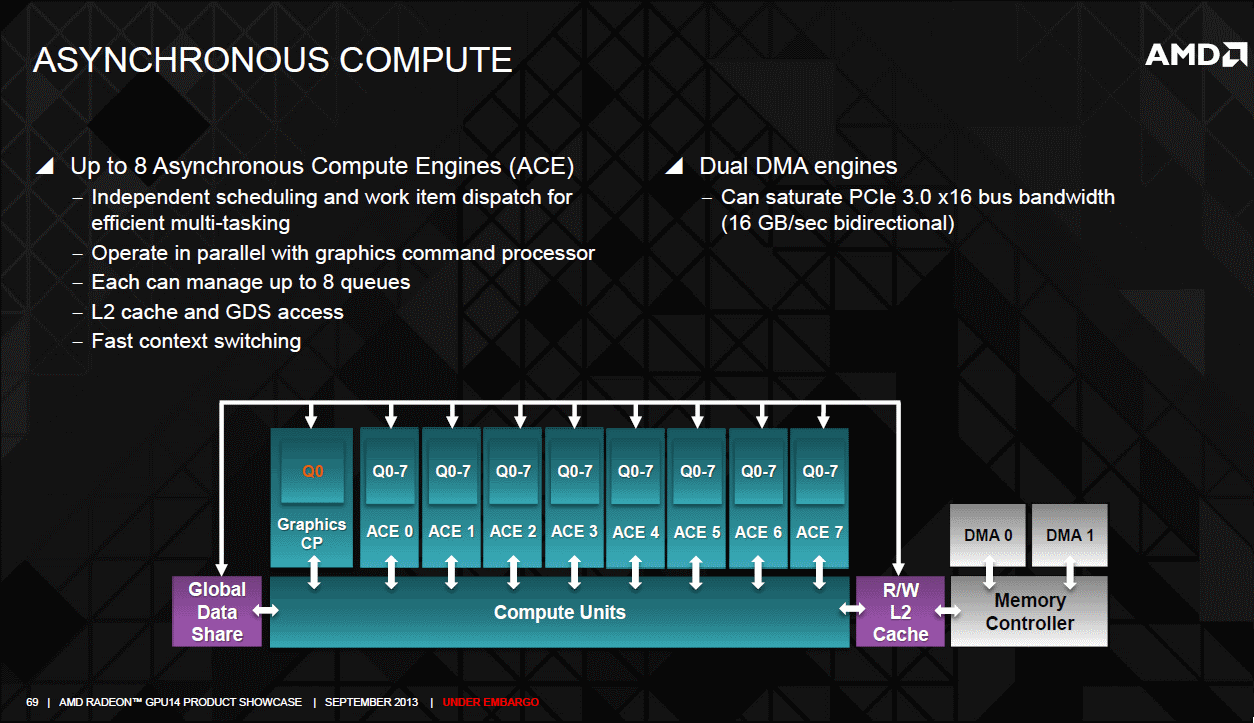
So in summary the layout of Graphics Core Next Architecture, 'version 2' as used in the 290X is essentially a scaled up version of Tahiti.
GCN '2.0' supports:
- 1-8 Asynchronous Compute Engines
- 1-4 Shader Engines
- 1-11 Compute Unit per Shader Engine, giving 64 to 704 shaders per Shader Engine
Tahiti v Hawaii – spec comparison
|
AMD Graphics Core Next |
AMD Graphics Core Next |
Increase | |
|---|---|---|---|
|
Compute Units/ IEEE-2008 Compliant Shaders |
32 / 2048 |
44 / 2816 |
1.4x |
|
Geometry Processors |
2 |
4 |
2.0x |
|
Render Back-Ends |
8 |
16 |
2.0x |
|
L2 Cache |
768KB |
1MB |
1.3x |
|
Memory Bus |
384 bit wide GDDR5 264 GB/sec |
512-bit wide GDDR5 320GB/s |
1.2x |
In addition to the increased GPU resources, Hawaii adds updating display controllers for Eyefinity, AMD TrueAudio and a new version of CrossFire.
GCN v Kepler Architecture Performance & Efficiency – spec comparison
|
AMD Radeon |
AMD Radeon |
Increase |
NVIDIA GeForce GTX 780 |
NVIDIA GeForce GTX TITAN ‘Kepler’ | |
|---|---|---|---|---|---|
|
Geometry Processing |
2.1 billion primitives/sec |
4 billion primitives/sec |
1.9x |
||
|
Compute |
4.3 TFLOPS |
5.6 TFLOPS |
1.3x |
4.0 TFLOPS |
4.5 TFLOPS |
|
Texture Fill Rate |
134.4 Gtexels/sec |
176 Gtexels/sec |
1.3x |
166 Gtexels/sec |
188 Gtexels/sec |
|
Pixel Fill Rate |
33.6 Gpixels/sec |
64 Gpixels/sec |
1.9x |
41.4 Gpixels/sec |
40.2 Gpixels/sec |
|
Peak Bandwidth |
264 GB/sec |
320GB/sec |
1.2x |
288 GB/sec |
288 GB/sec |
|
Die Area |
352 mm^2 |
438 mm^2 |
1.24x |
561 mm^2 |
561 mm^2 |
|
Peak GFLOPS/mm^2 |
12.2 |
12.8 |
1.05x |
7.1 |
8 |
While Peak raw power and computing have not significantly increased, the GPU’s horsepower within its engines is much stronger with almost 2x throughput available for 3D Graphics intensive tasks such as pixel shaders and geometry at only a 25% increase in die size. On paper 290X is more efficient, thanks to its ‘higher horsepower’ design at a smaller die size than the Kepler GK110 based GTX 780.
On paper, 290X provides a good step-up from the previous generation HD 7970. The lower compute performance for NVIDIA GeForce is expected as this is a hallmark of their consumer oriented GPU.
AMD TrueAudio - Graphics is only half of the picture
Although we will be covering TrueAudio in a dedicated review, especially when the software is ready this chapter serves as an overview.
During AMD’s GPU14 Hawaii webcast, the firm did not make it clear how it would actually enable its TrueAudio technology, they only disclosed what it would do.
We initially speculated that Hawaii would use the power of GCN’s compute capability to process 3D positional audio using OpenAL as was the case with Creative SoundBlaster and NVIDIA SoundStorm, plus Apple devices.
The launch middleware for TrueAudio was AstoundSound. This system, according to its developer is a fully software based solution so GPU compute made sense initially. The only caveat here would have been slowdowns or resource wastage when processing audio. A secondary factor leading us to this conclusion was the extensive positional audio keynotes made last year at AMD’s developer’s conference.
We can now reveal that 260X and 290X cards do indeed contain hardware DSP cores for processing audio, Tenscilia’s Hi-Fi DSP product that AMD has used in multiple within the GPU. DSP calculations are CPU intensive and GPU compute may have been sufficient in hindsight.
The Hi-Fi DSPs combined with various 3D Audio middleware and the Existing Multi-Display Directional audio present in Radeon GPUs which pipes audio over HDMI or DisplayPort gives the end user a free DSP-based Digital only Sound Card.
For analogue audio output or digital SPDIF out, users utilise their existing on-board or discrete audio solution.
For analogue speakers via HD Audio on-board CODEC this is an acceptable and flexible solution, however the user is limited by the quality of their hardware.
For discrete sound card users using analogue speakers, the software or hardware DSP processing capability of the sound card can be used on top of the incoming AMD TrueAudio processed streams.
However, if AMD TrueAudio is handling processing of game audio via middleware then this renders the gaming specific capability of a DSP sound card such as Creative’s relatively new Sound Core 3D processor ( which utilises ‘quad DSP cores’ ) somewhat moot. The game audio has already been processed and offloaded upstream
It is still early days for this system and it is solely reliant supporting software, unlike a integrated or discrete sound card. Although three games have been announced as supporting TrueAudio: Murderded:Soul Suspect, THEIF and Lichdom, THEIF might be the showcase title thanks to is environment
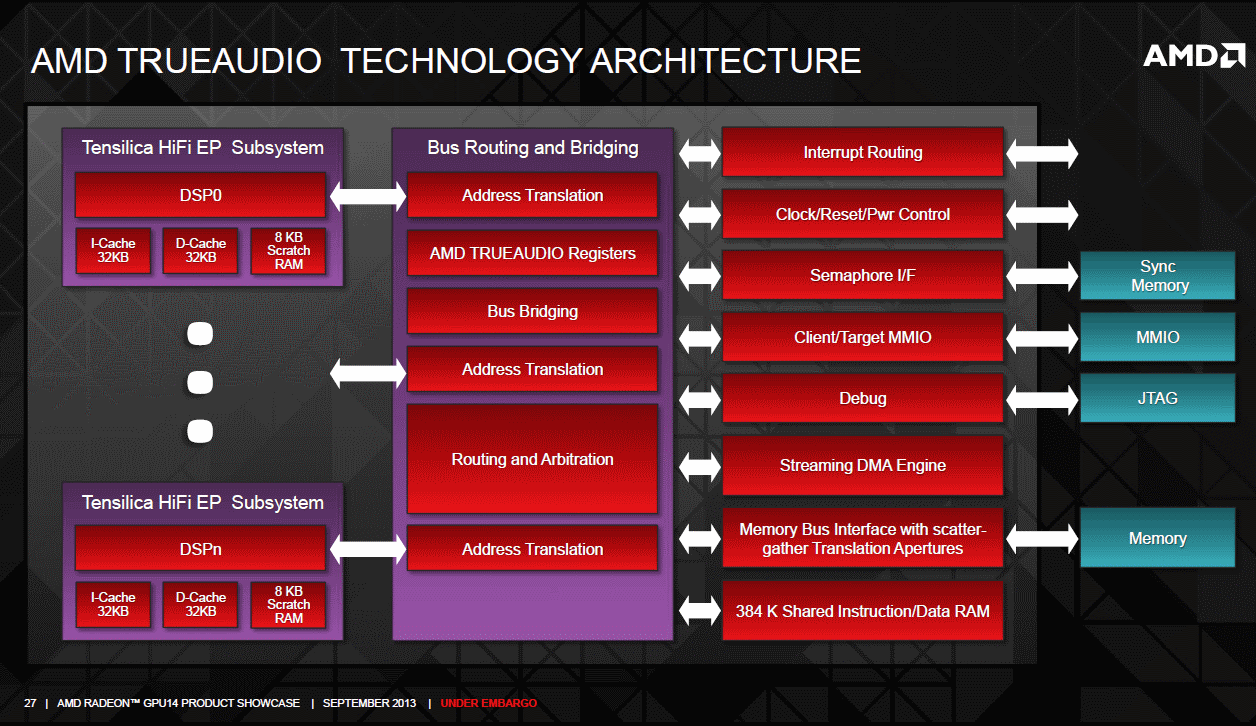
The TrueAudio system can access up to 64 MB addressable space in frame buffer, similar to how Creative's X-Fi could utilise its own DRAM for audio processing.
Radeon R9 290X - AMD's single GPU powered flagship video card
In this launch article we are only focusing on the 290X. The lower spec 290 is soon to follow. In the product stack relative to southern islands, the 290X and 290 take the spots of the HD 7970 and 7950 once held.
Based on prior Radeon generations, It is likely that sometime in the future a third 290 series member will be introduced based on the yields of the GPUs themselves and to fill price/performance gaps in the top to bottom GPU line-up.
The tricky part here when describing the 290X is that it is not a direct replacement for the 7970 but a successor. 7970 continues in the existing 7970, 7970 GHz edition and in refreshed form as the R9 280X.
AMD have reorganised is product stack the same way it did during 2010-2011 when it introduced its Radeon HD6900 Cayman parts, introducing new flagship cards and cascading down the previous flagships in refreshed form to the affordable mainstream-performance segment.
NVIDIA also has taken this approach for its GeForce 700 series, cascading down its once flagship GK104 'Kepler' core to more affordable cards and or boosting its capabilities, with the GK110 based Kepler parts such as the TITAN taking over flagship duties.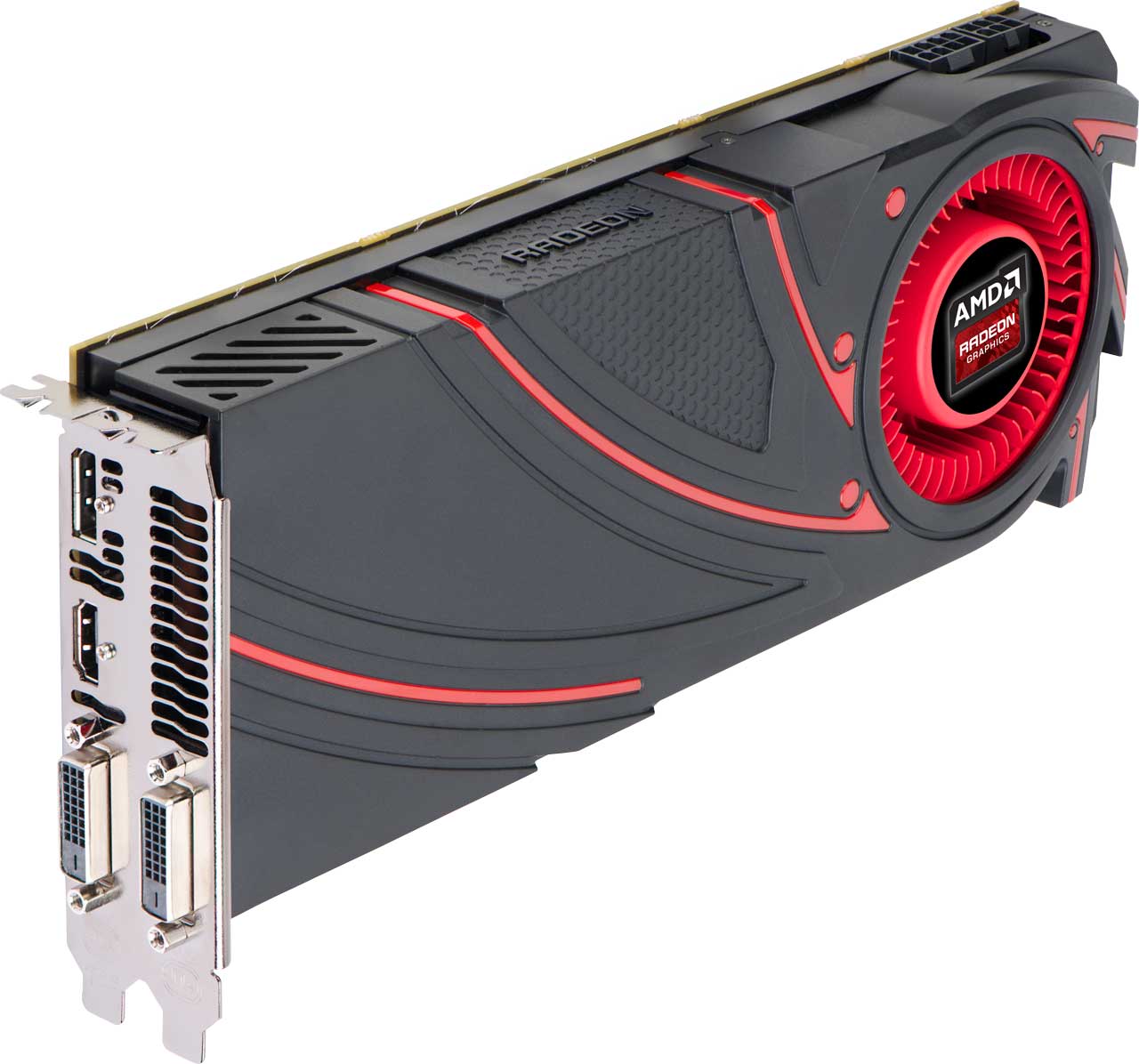
Comparing specs, we will not be contrasting the 7970 GHz edition with the 290X, but comparing the original HD 7970 as it was originally available in January 2012 with the new 290X, going from generation to generation.
The highlights of the 290X are:
- New version of Graphics Core Next GPU
- 4GB memory for optimal 4K gaming
- Increased performance at 4K with 1.4x shader cores and 2x the Render Back ends
- Updated bridgeless, Crossfire over PCI BUS allowing for better card position/cooling
- Updated Eyefinity, supporting 3 HDMI/DVI Displays + 1 DisplayPort over 2+1 on 7970
- AMD TrueAudio technology
- Enhanced Overdrive and PowerTune controls for tweaking and overclocking
- Updated styling
Board Specs
|
|
Radeon HD 7970 “Tahiti” |
Radeon R9 290X “Hawaii” |
Increase |
|---|---|---|---|
|
Processors |
2048 |
2816 |
1.38x |
|
Core Speed |
925 MHz |
850 MHz Base,Up to 1 GHz Boost |
|
|
Memory Size |
3GB GDDR5 |
4GB GDDR5 |
1.2x |
|
Theoretical Compute |
3.5 Teraflops(launch) |
5.6 Teraflops |
1.6x |
|
Multi GPU |
4 cards via Bridge |
4 via PCI Express 3.0 bus |
|
|
Displays |
Eyefinity ‘2.0’: * 2x mini DisplayPort 1.2 HBR2 |
Eyefinity ‘3.0’: |
|
|
Transistor Count |
4.3billion |
6.2billion |
1.44x |
|
Board Power |
225 Watts, 1x8pin + 1x6pin Power |
300 Watts, 1x8pin + 1x6pin Power |
1.33x |
|
Tuning |
ZeroCore |
ZeroCore |
|
|
Video and Audio |
AMD VCE and UVD |
AMD VCE and UVD |
|
|
API Support at launch |
DirectX 11.1 |
DirectX 11.2 |
|
|
Launch Date |
22nd December 2011 |
24th October 2013 |
|
|
General Availability |
January 2012 |
November 2013 |
|
|
Price |
US$550 MSRP |
AU $699 RRP |
|
Performance, Thermal and Acoustic tuning
AMD are not disclosing base clock speeds and emphasing turbo speeds only this generation. There are some technical merits for this with the way boost/turbo works, but we feel this number should have been disclosed as AMD does with its CPUs and NVIDIA does with its GPUs
Hawaii based 290s see the continued use of the hardware toggle switch to switch between BIOS profiles.
BIOS profile 1 is ‘quiet’ for everyday use. BIOS profile 2 is ‘uber’ and provides more aggressive boost and limiters. AMD recommends this mode for users who do not require quieter computing or for Crossfire.
A reboot is needed to switch. It may have been time to allow profile switching on the fly in the way a motherboard BIOS could be tuned.
One of the concerns of the Tahiti HD7900 cards was the acoustics of the reference cooler fan which AMD claim to have addressed. Thermal wise 290X sports a new design ID for the heat sink but we suspect little has changed since the “6th generation vapour chamber” cooler the original HD 7970 used.
AMD designed the faster 7970 GHz edition for a typical design power of 250 watts and a peak design power of 300 watts. This experience leads to the thermal design for the 300W 290X.
Acoustics and Thermals are addressed through overhauled Overdrive and Powertune controls, which provide too much control even for advanced users. Sliders or knobs should have been the way to go not a infinitely variable XY Map
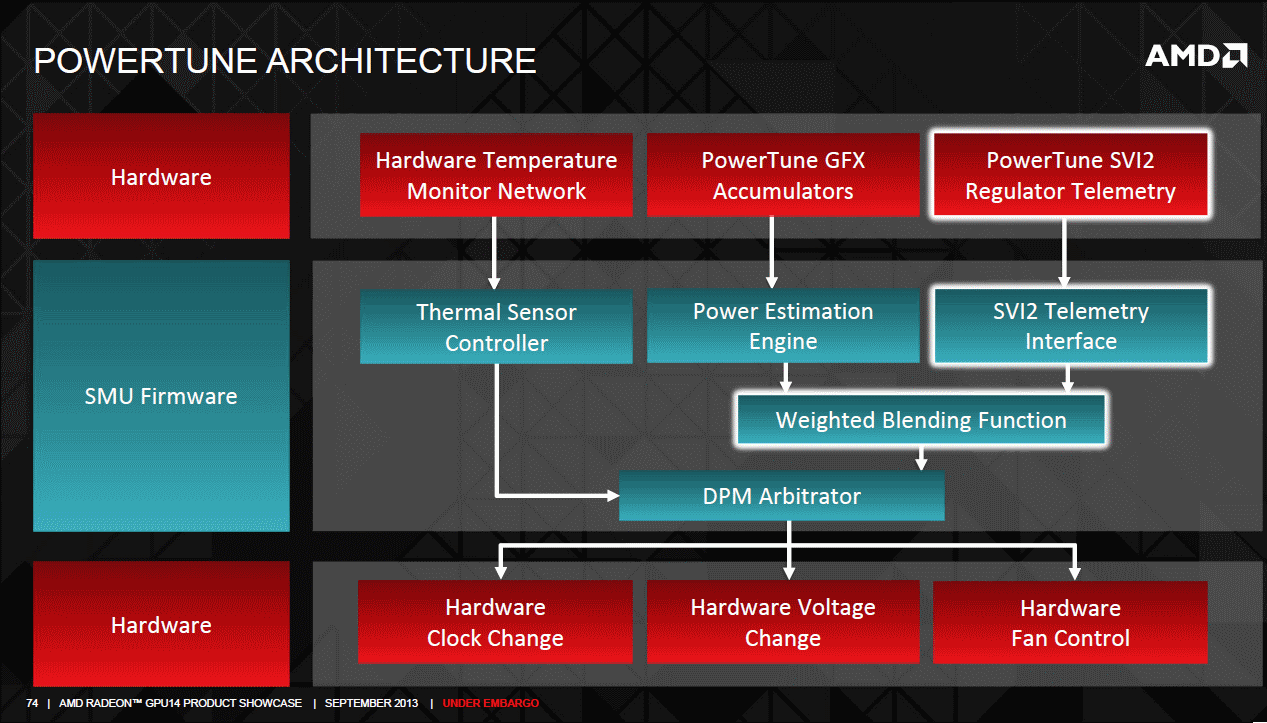
The old way of tweakng AMD's Powertune controls was simply clockspeeds, fan speed and a power limit slider, as shown from our Janurary 2012 launch review of Radeon HD 7970
This generation, the fan speed slider sets the maximum fan speed not a constant fan speed ensuring quieter operation when possible.
AMD’s Powertune manifesto guiding the new feature:
- Leave No watt Unused
- Produce No Unnecessary Noise
- Allow Complete Customisation
- Maximise The Potential
‘Next Generation’ Powetune is able to switch voltages for 290X, 260X and FM2 CPUs in around 10 microseconds and with 255 steps between 0 and 1.55V
R9 290X Benchmarks
Given AMD's lacklustre launch in the eyes of end users/media and limited sampling/availability, we can only go by AMD's own benchmark numbers provided to reviewers.
In the numerous times evaluating AMD products we have found their reference numbers have been somewhat correct and replicable however these cannot be taken as the final word and independent verification is always required.
The purpose of including these reference benchmarks is not for substitution, but to highlight different game titles have has selected for its own 'competitive analysis'.
We would rather have some benchmarks in our launch coverage, which we will analyse anyway rather than nothing at all.
The main issue with how AMD is promoting 290X performance to the media is that it has been inconsistent with its games test suite across different resolutions and tests.
Additionally, Smoothness, Stutter, Frame rate limiting and Frame Pacing were not highlighted as bullet point features; however 290X remains compatible with frame pacing.
3DMark Fire Strike
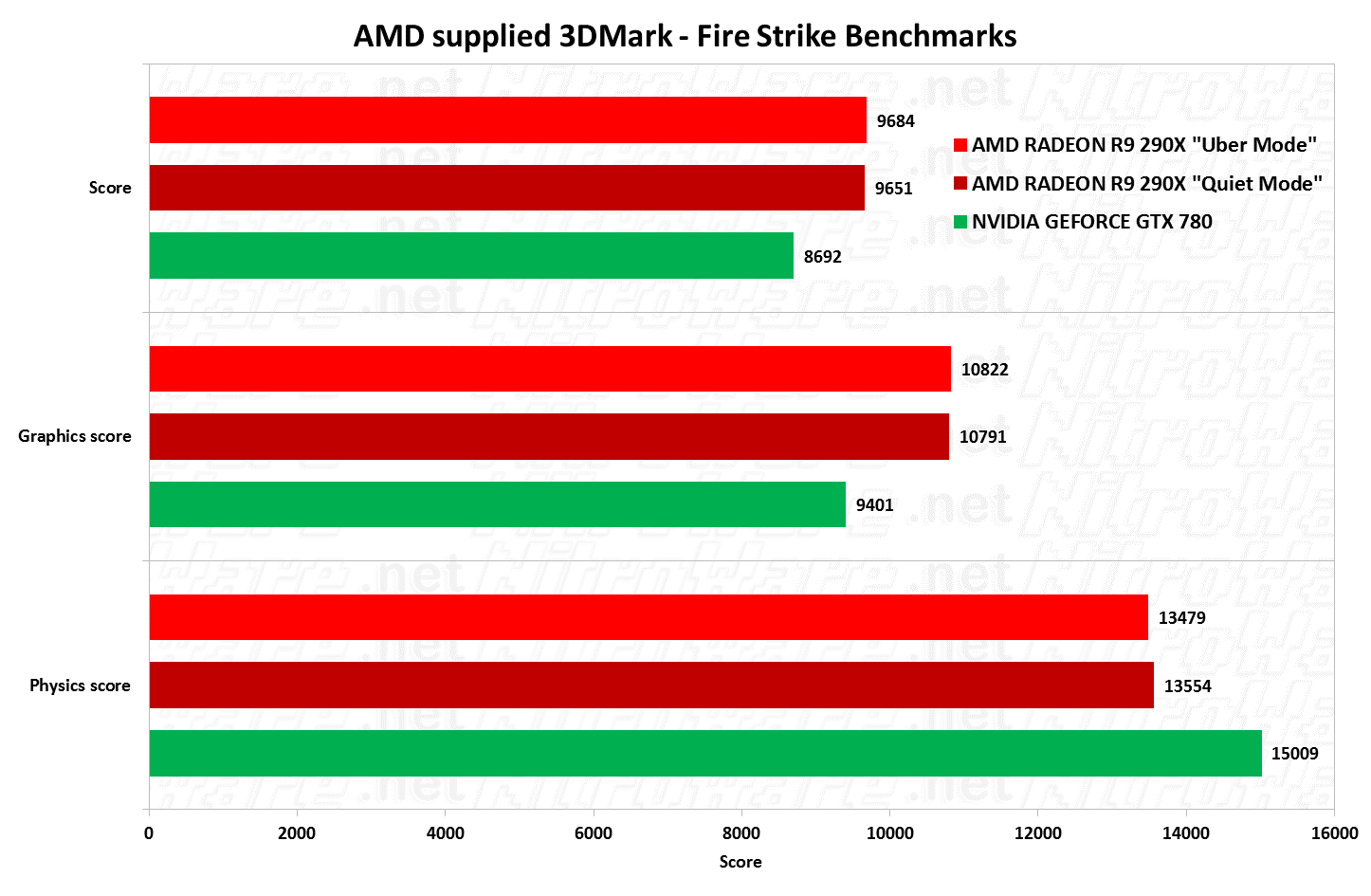
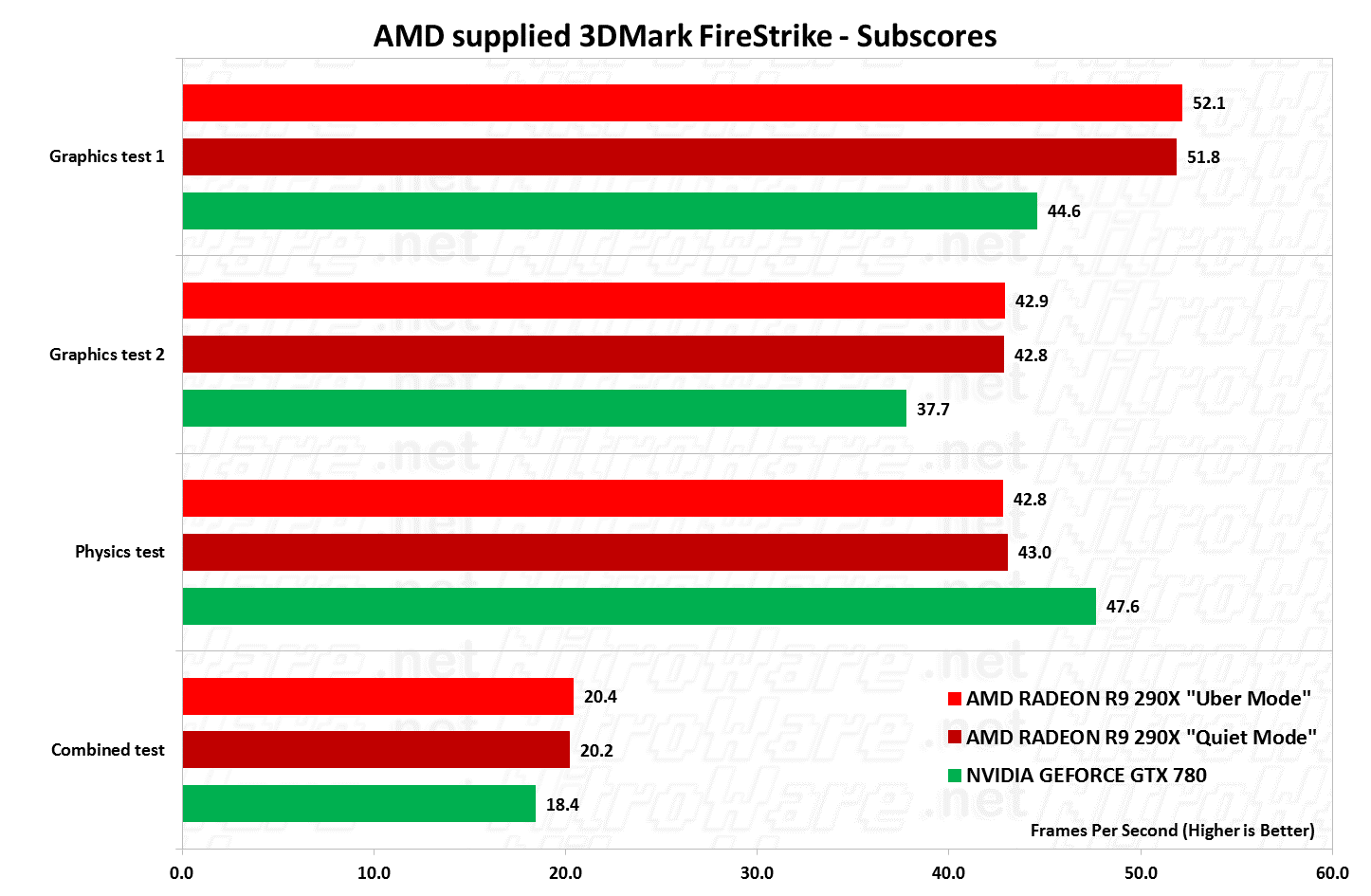
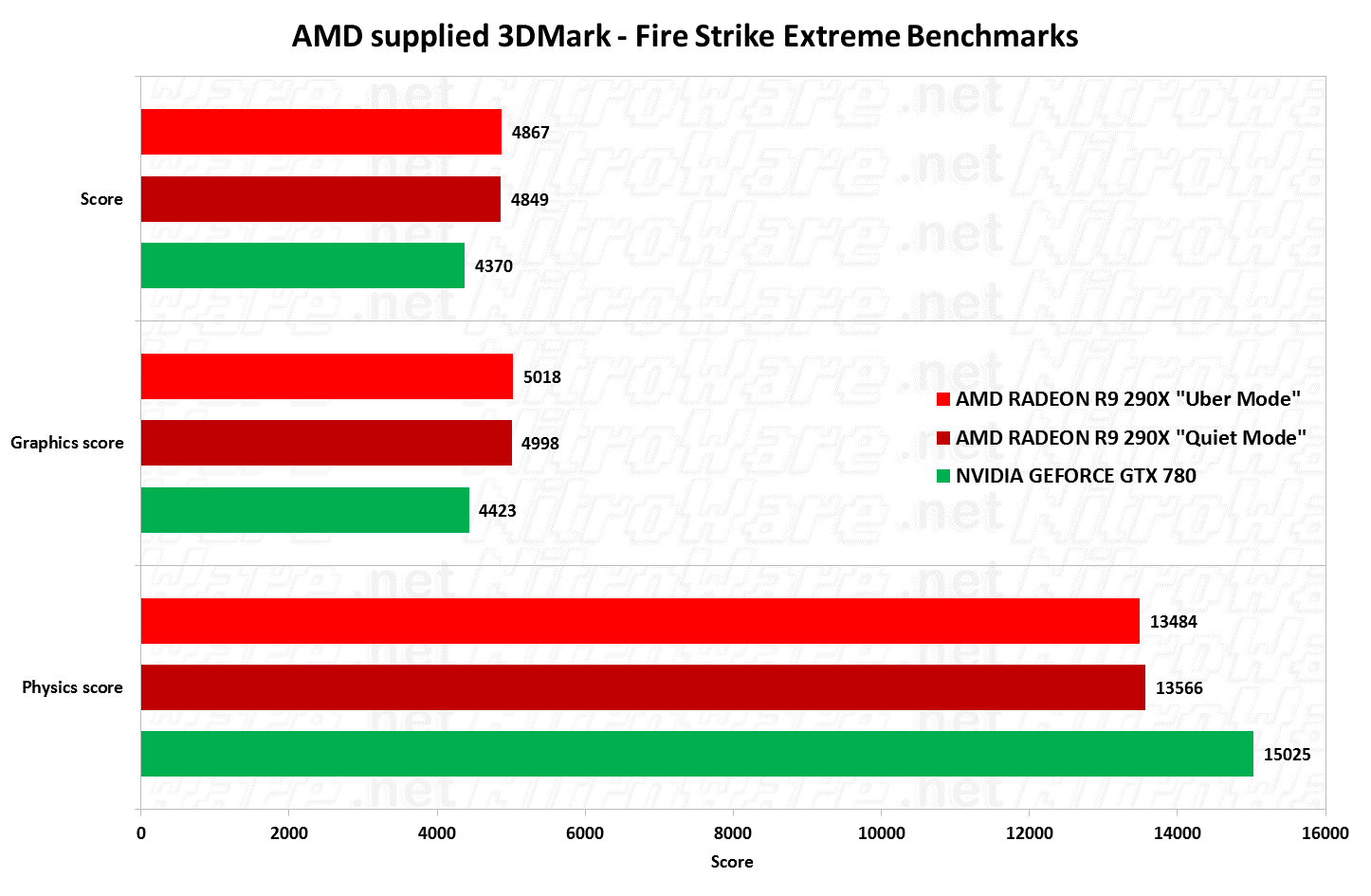
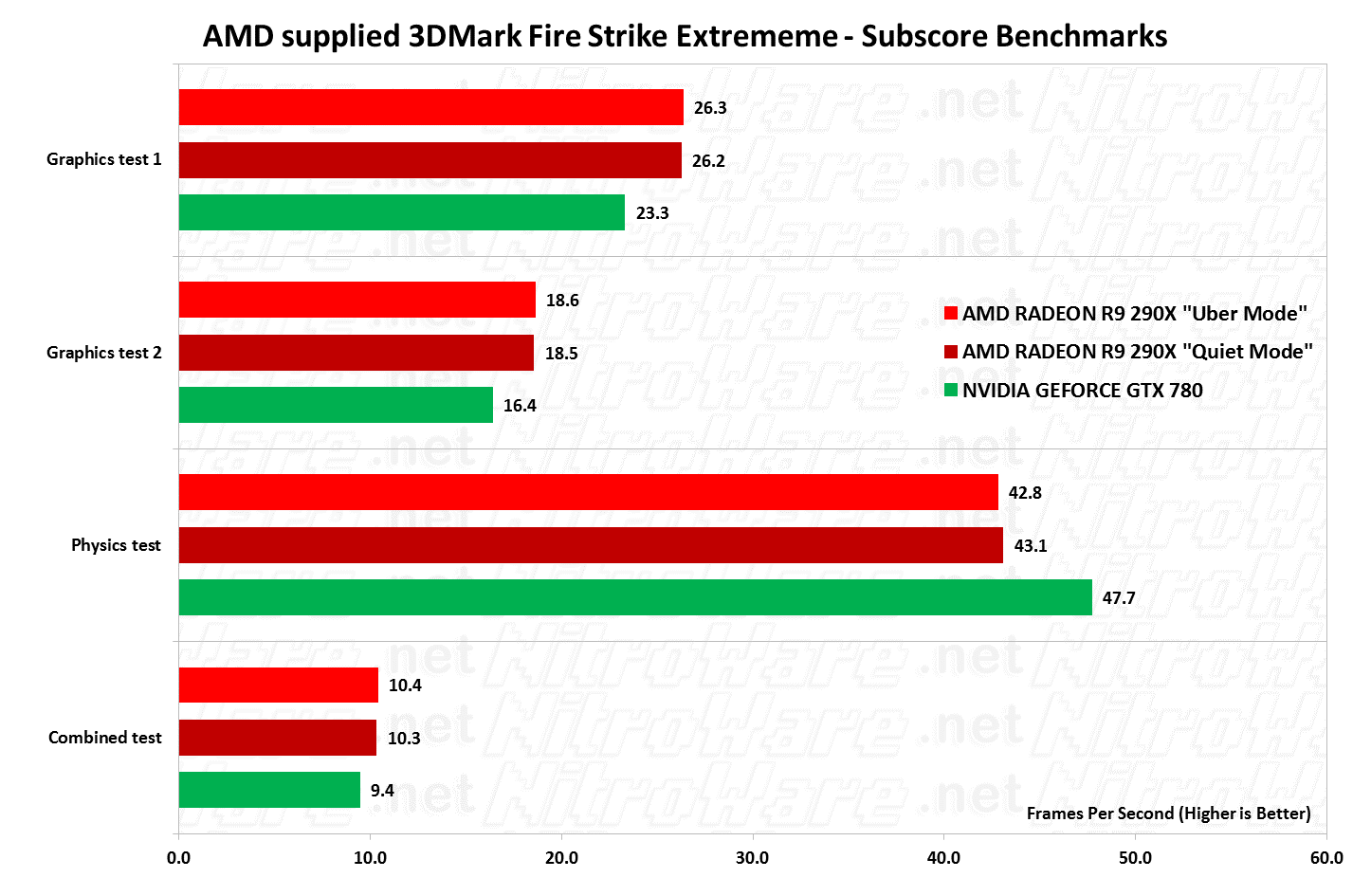
Futremark's documentation for the physics tests states "The GPU load is kept as low as possible to ensure that only the CPU is stressed." NVIDIA's drivers are likely better optimised for the bullet physics which the test uses.
4K Single Monitor Gaming Benchmarks
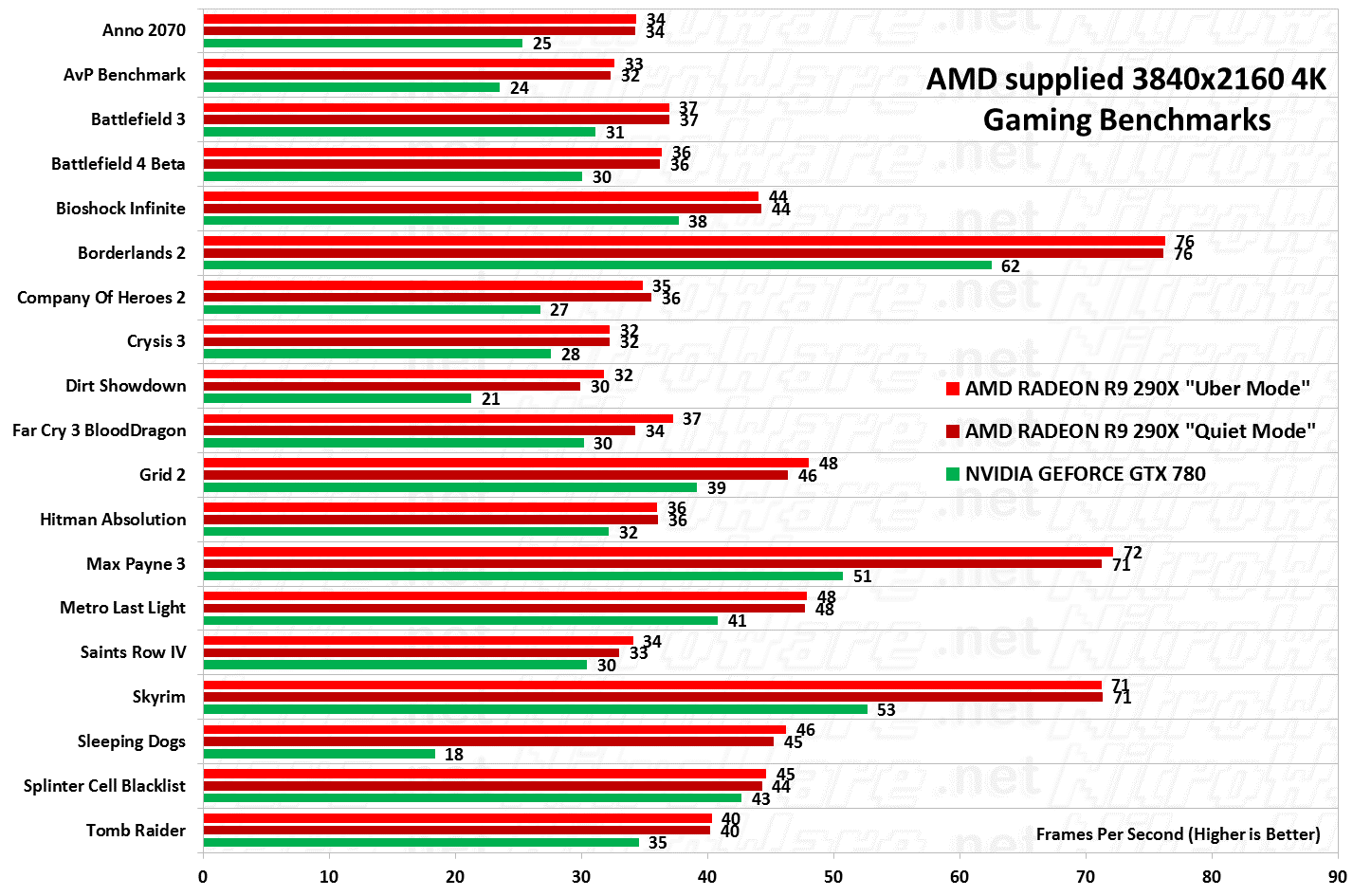
4K is the main focus of the 290X and the usual suite of AMD tests includes some popular titles that AMD typically does not publically highlight as part of its gaming efforts such as Anno 2070, Company of Heroes 2 and Skyrim
Unlike Eyefinity, the deltas between AMD and NVIDIA are a bit more severe at single monitor with 10FPS difference being common and more titles showing 20FPS gain for Radeon.
GTX780 supposedly cannot maintain 30FPS for several popular titles at 4K while 290X does not drop below 30FPS for any title.
4K CrossFire Gaming Benchmarks
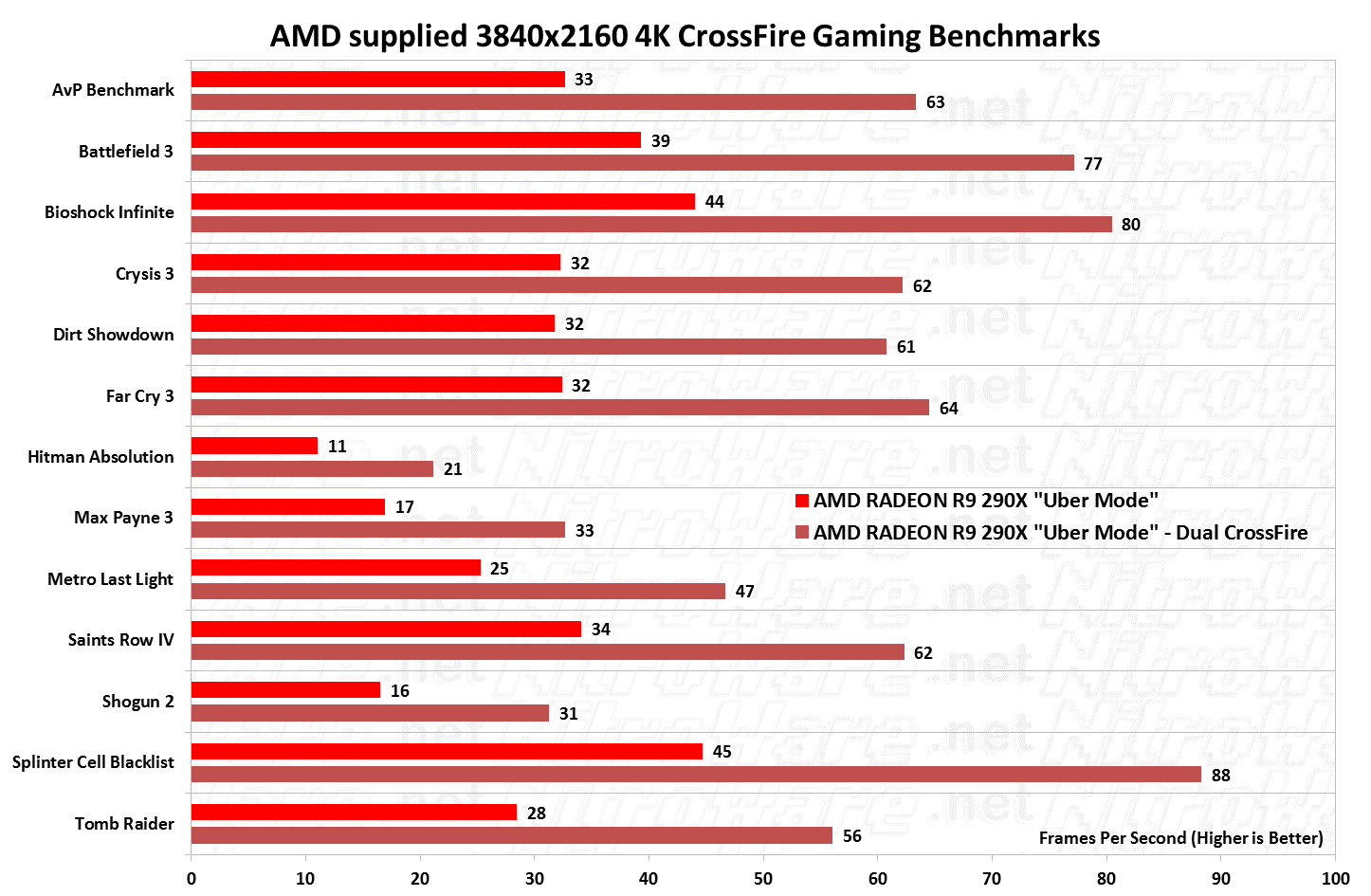
Although R9 290X is 'built for 4K gaming' and this is what AMD wants to show off, a single card only produces typically 30FPS at 4K and the near 2x scaling of crossfire is needed to approach fluid 60FPS, especially since is supported by SHARP's 4K monitor platform
Of the 13 games AMD used for 4K Crossfire testing:
AvP Benchmark (dating back to the HD5800 days), Bioshock, Crysis3, DIRT Showdown, Far Cry 3, Hitman, SHOGUN 2 and Tomb Raider are AMD Gaming Evolved program titles and heavily associated with AMD Radeon benchmarking and game bundles
Max Payne 3 especially Metro Last Light are associated with NVIDIA and part of The Way Its Meant to be played program.
Based on AMD's scores 290X acheives under 2.0x scaling which is typical of previous DirectX 11 Radeons.290X's new bus based crossfire sysem does not seem to signficantlyl improve crossfire scaling numbers, however we note that these tests are at 4K (8.3megapixels) not 1080p (2.07Megapixels), four times the pixel data.
Three 290X deliver 2.60 to 3 X scaling
AMD has chosen (unfairly) not to compare 4K CrossFire with 4K SLI
Eyefinity/Surround Gaming Benchmarks
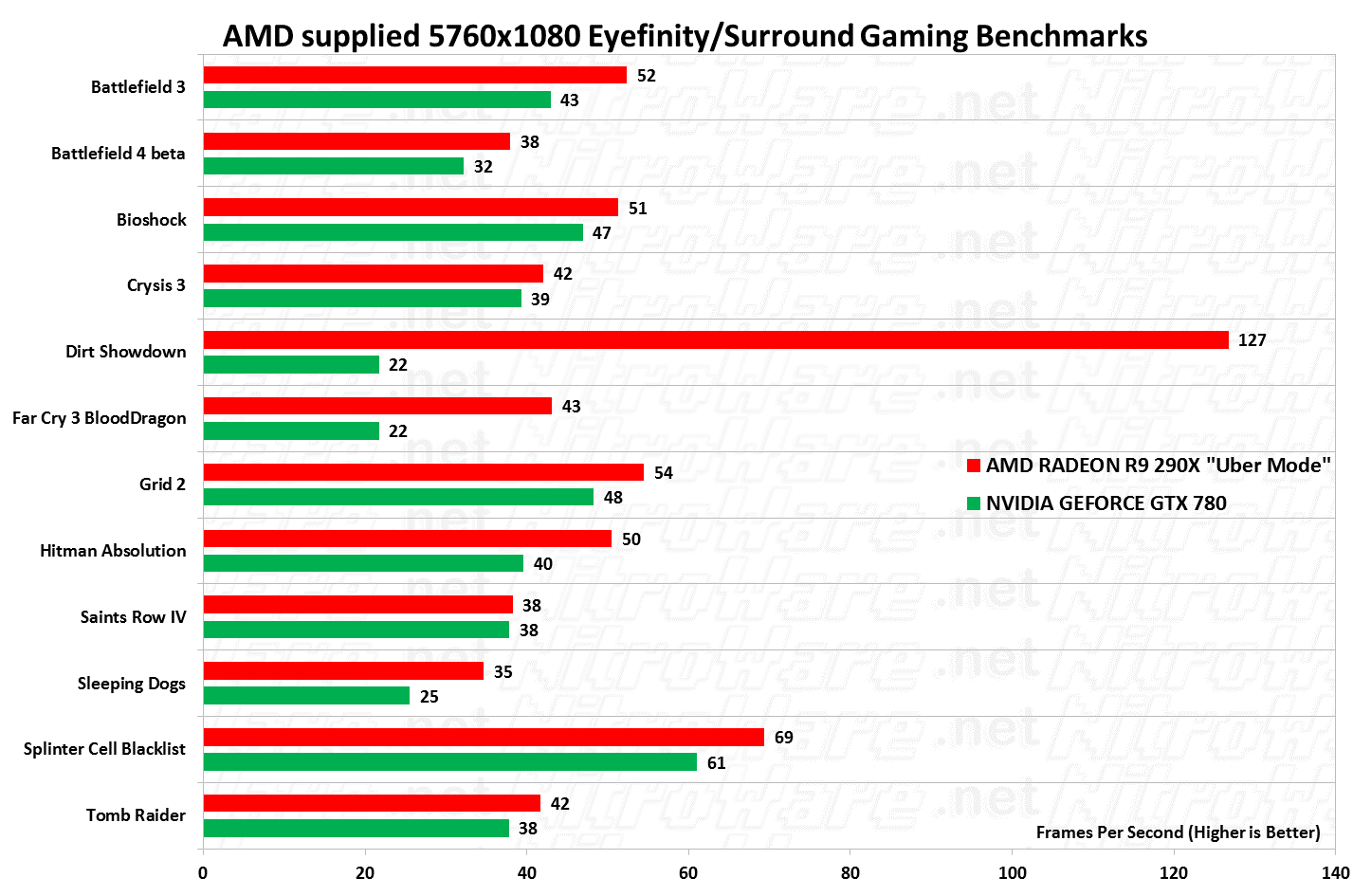
Of the 12 games AMD selected for surround resolution tests, 8 are under AMD's Gaming Evolved developer relations program being:
Bioshock Infinite, Crysis3, DIRT Showdown, Blood Dragon, Hitman: Absolution, Sleeping Dogs and Tomb Raider. All 8 of these games were also bundled with AMD products.
Of the other 4 games being Battlefield 3, GRID 2, Saints Row IV and Splinter Cell Blacklist,
DICE is taking care to optimise for AMD, and claiming Battlefield 4 is highly optimised for AMD.
GRID 2 is an Intel endorsed title which includes support for Iris Graphics specific features
Splinter Cell Blacklist is a NVIDIA The Way Its Meant To Be Played endorsed title.
Apart from the erroneous result for DIRT Showdown, the Deltas between R9 290X and GTX780 are competitive with exception of 10- 20FPS for Battlefield 3, Blood Dragon, Sleeping Dogs and Splinter Cell.
R9 290X Pricing and Availability
Pricing
NVIDIA GeForce GTX 780
The cheapest GTX780s as of 24-October 2013:
| Region | Board | Local Price | Converted Price | Source |
| Australia | Gainward GTX 780 | AUD $699 | AUD $699 | statice.com.au |
| United States | ZOTAC GTX 780 | USD $625 | AUD $651 | pcpartpicker.com newegg.com |
| United Kingdom | ZOTAC GTX 780 | GBP £503 | AUD $844 | scan.co.uk |
| Europe | ZOTAC GTX 780 | EUR €526 | AUD $725 | geizhals.at |
AMD Radeon R9 290X
Suggested Retailer Pricing for both US and AU was only provided at the last minute. AMD has been holding this close to their chest and was not received until embargo lift time
For the 290X, limited Australian channel pricing is available at launch as of 24 and 27th October:
| Region | Board | Local Price | Converted Price | Source |
| Australia | PowerColor R9 290X Sapphire R9 290X Battlefield 4 edition |
AUD $659 AUD $699 |
AUD $659 AUD $699 |
statice.com.au |
| United States | Sapphire R9 290X Battlefield 4 edition | USD $579 | AUD $603 | newegg.com |
| United Kingdom | MSI/XFX/ASUS R9 290X | GBP £485 | AUD $818 | scan.co.uk |
| Europe | MSI R9 290X | EUR €526 | AUD $757 | geizhals.at |
Availability
Availability in distribution channel, e-tail and retail of 290X should be first week of November.

Due to selective sampling, extremely limited availably and tight deadlines we are unable to source a review sample to perform our own testing although we had full access to all information and data regarding the new GPUs under AMD and Add in Board Partner embargo. We have even heard numbers for the special Battlefield 4 edition cards (via pre-order) were as low as 8000 units.
Discussions with Add in Board Partners pre-launch revealed that stocks of cards at launch time are extremely limited, to such a degree that these firms are not sampling boards to media in some regions especially since 290Xs will be reference cards initially.
Verdict
As far as positioning goes, AMD's view is the 290 is comparable with the GTX780 as these cards are in the same performance bracket. Efforts have been made to ensure the 290X is not compared with NVIDIA's GTX TITAN. Despite having different price points, TITAN is an enthusiast, not professional product so comparisons can be made if taking into account price points.
AMD loves to hold the 'fastest GPU in the world'. When evaluating this claim we must look at all single board solutions, consumer and professional.
All R7 and R9 Volcanic Islands based products are not eligible for Never Settle which makes older HD 7000 cards more attractive especially at discounted price points.
If you are in the market for an upgrade from an older board including a HD 58/5900, 6900 or 7970, 290X is a fine upgrade path.
Do not sell your current high end Kepler card especially a GTX780 thinking the 290X is a NVIDIA killer. Even AMD's own reference scores show 10-20 FPS in many scenarios, which does not justify a signficant investment.. Dual Kepler in SLI or Dual 290/X in Crossfire is the correct upgrade path from a single high end NVIDIA Kepler based GPU.
A future Dual Hawaii based '290X2' would be a price/performance competitor to the TITAN, however the debate over single v dual GPU comparisons loom. TITAN still has superior texturing fillrate.
Hawaii's GCN design coupled with 28nm process can't be scaled up apart from clock speeds or power limits. All Shader and compute units are enabled on the 290X. What you see is what you get for at least the next few months.
In raw crunching power alone, dual 7970s still exceed the performance of a single 290X.
Raw teraflops should not be used a sole metric for choosing a graphics card as other aspects of the design affect game performance. Those with dual 7970s should consider upgrading to dual Hawaii cards to maximise their investment and graphics performance headroom rather than a single flagship GPU.
On paper, the 290X is AMD's well-received GCN architecture with the knob turned up to 20. Some icing on the cake such as overhauled PowerTune controls, bridgeless Crossfire and a new visual identity sweeten the deal, but AMD could have offered much more in hardware and software this time. Perhaps these will arrive on next time.
The Hawaii chip is an evolution not a revolution, where as Tahiti was a revolution bringing many new features to the table for the first time. NVIDIA's Kepler is the same here, Kepler in GeForce 600 form was a revolution while GeForce 700 and TITAN were evolutions.
AMD and independent reviews may claim victory for 290X with better price/performance over GTX 780 and GTX TITAN , but NVIDIA has sweetened their deal in time for AMD's launch with a game bundle. Their bundle has THREE of the latest AAA titles with its performance GPUs, Batman Arkham Origins (A$50), Assassins Creed IV Black Flag ($A70) and Splinter Cell Blacklist($A70), giving A$190 total value if these are purchased on STEAM.
NVIDIA did not comment regarding ANZ/APAC game bundle avalbiilty by press time.
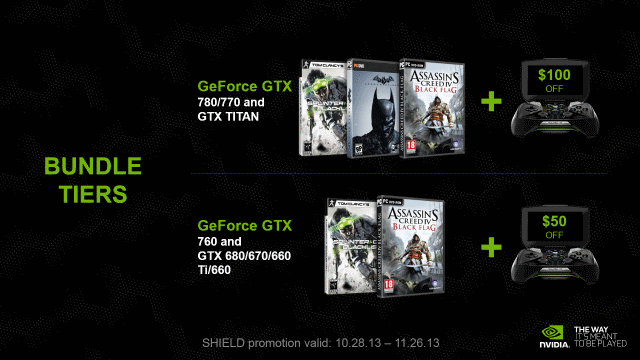
When considing the NVIDIA package, including the SHIELD gaming discount, games and NVIDIA specific features such as near perfect Frame Pacing, PhysX, G-Sync, TXAA and others make the GeForce GTX offering competitive if not better choice than AMD's. Which package suits you depends on wether you are interested in the game bundle.
AMD needs to try much harder in all aspects of company operations and product development both for CPU and GPU. However, stay tuned for news about the cheaper R9 290, which should offer very good better price/performance.
On a nostalgic note...
